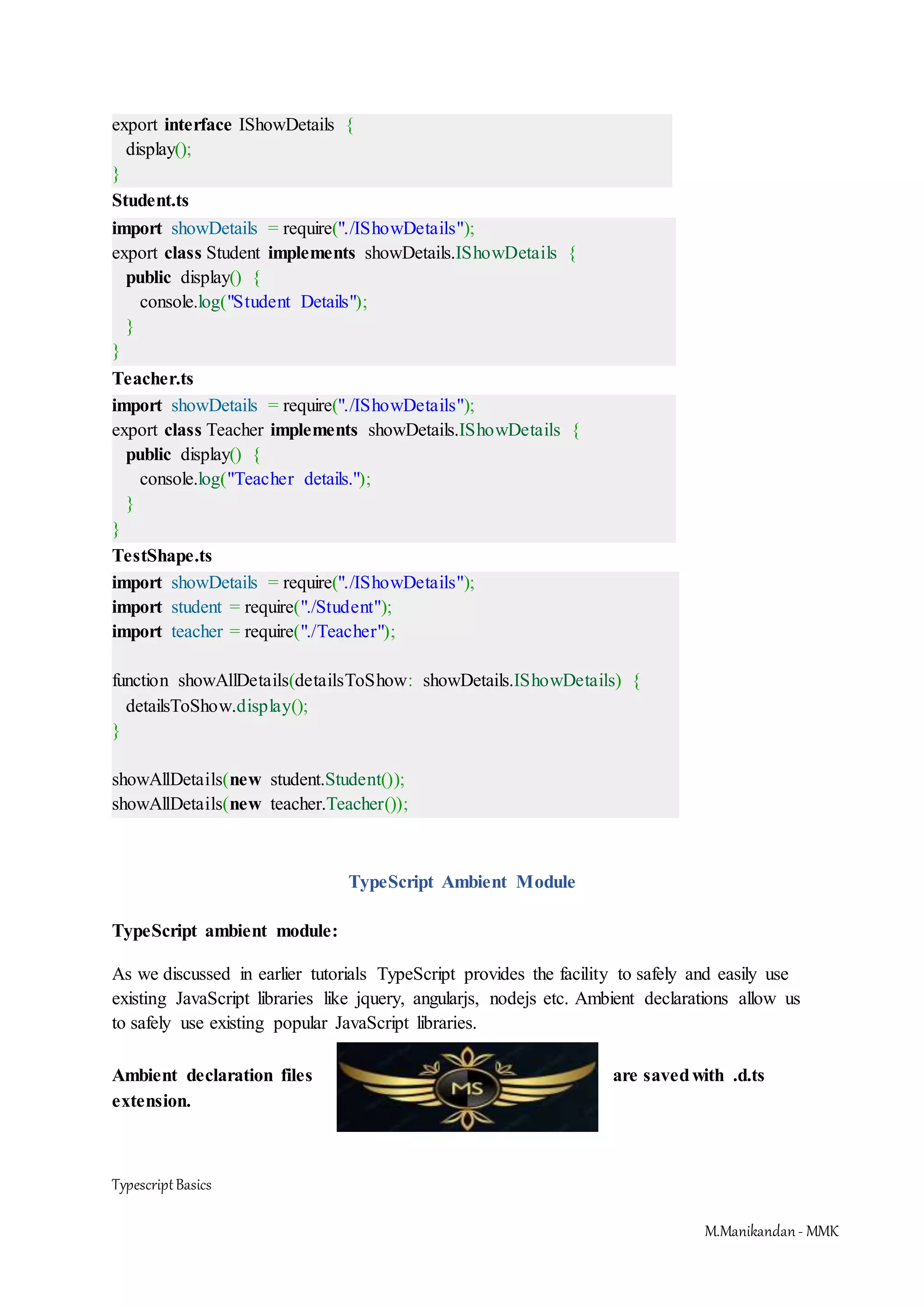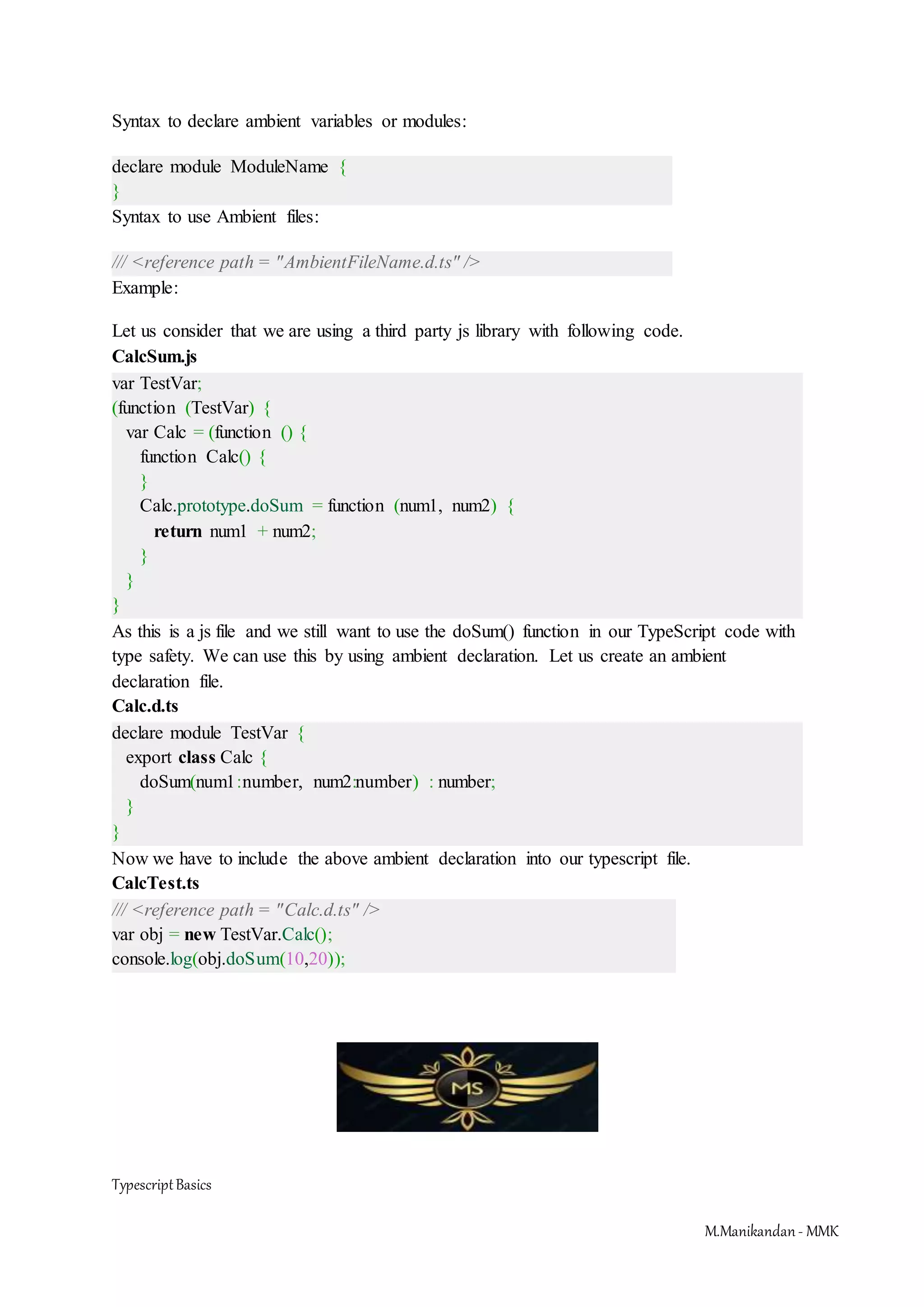TypeScript is a superset of JavaScript that primarily provides optional static typing, classes and interfaces. It allows IDEs to provide richer coding environments through features like type checking and code completion. TypeScript code is compiled to JavaScript that runs in browsers. It is open source and designed by Anders Hejlsberg at Microsoft to provide object-oriented capabilities to JavaScript. TypeScript supports features like classes, interfaces, static typing, and modules.
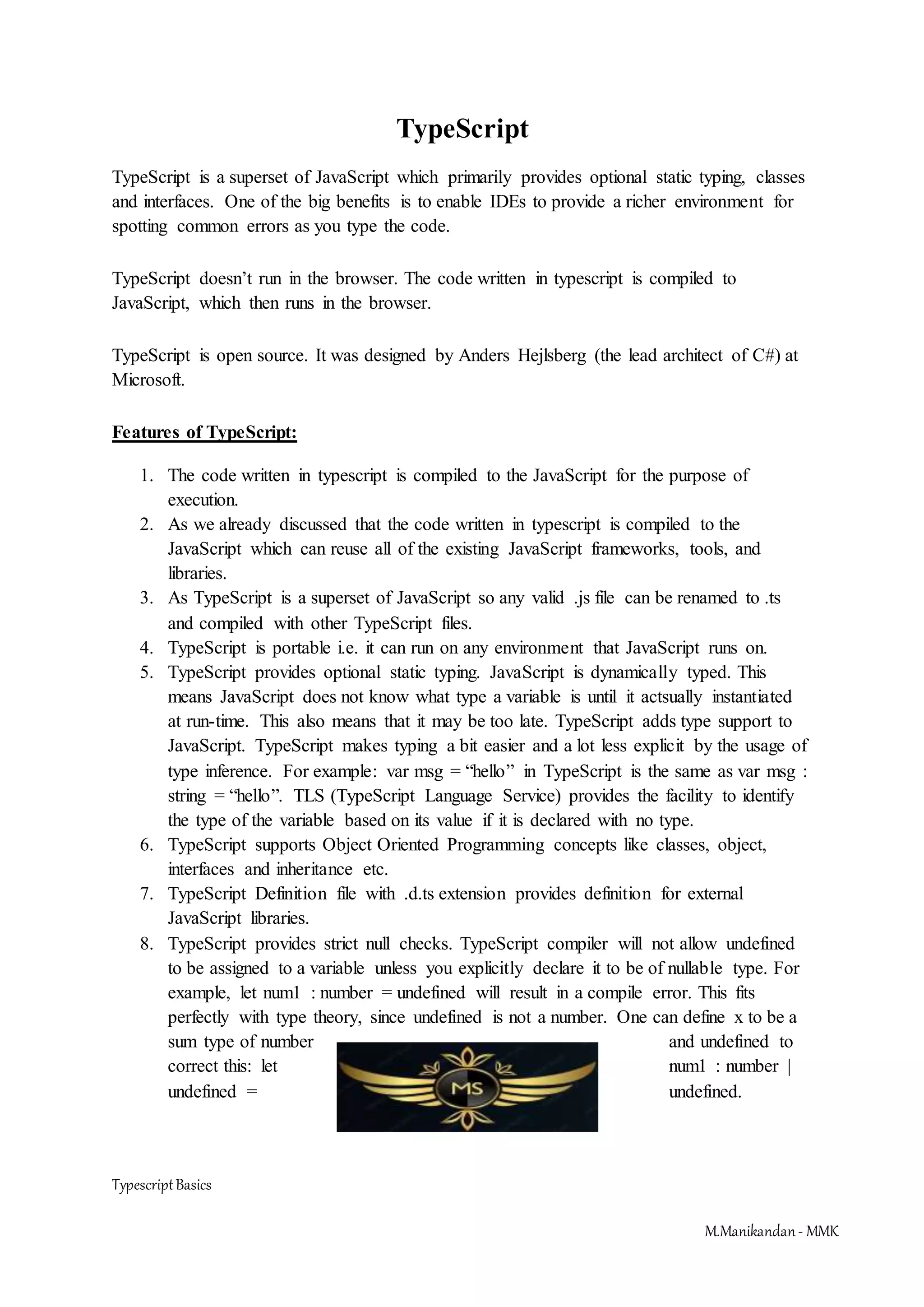
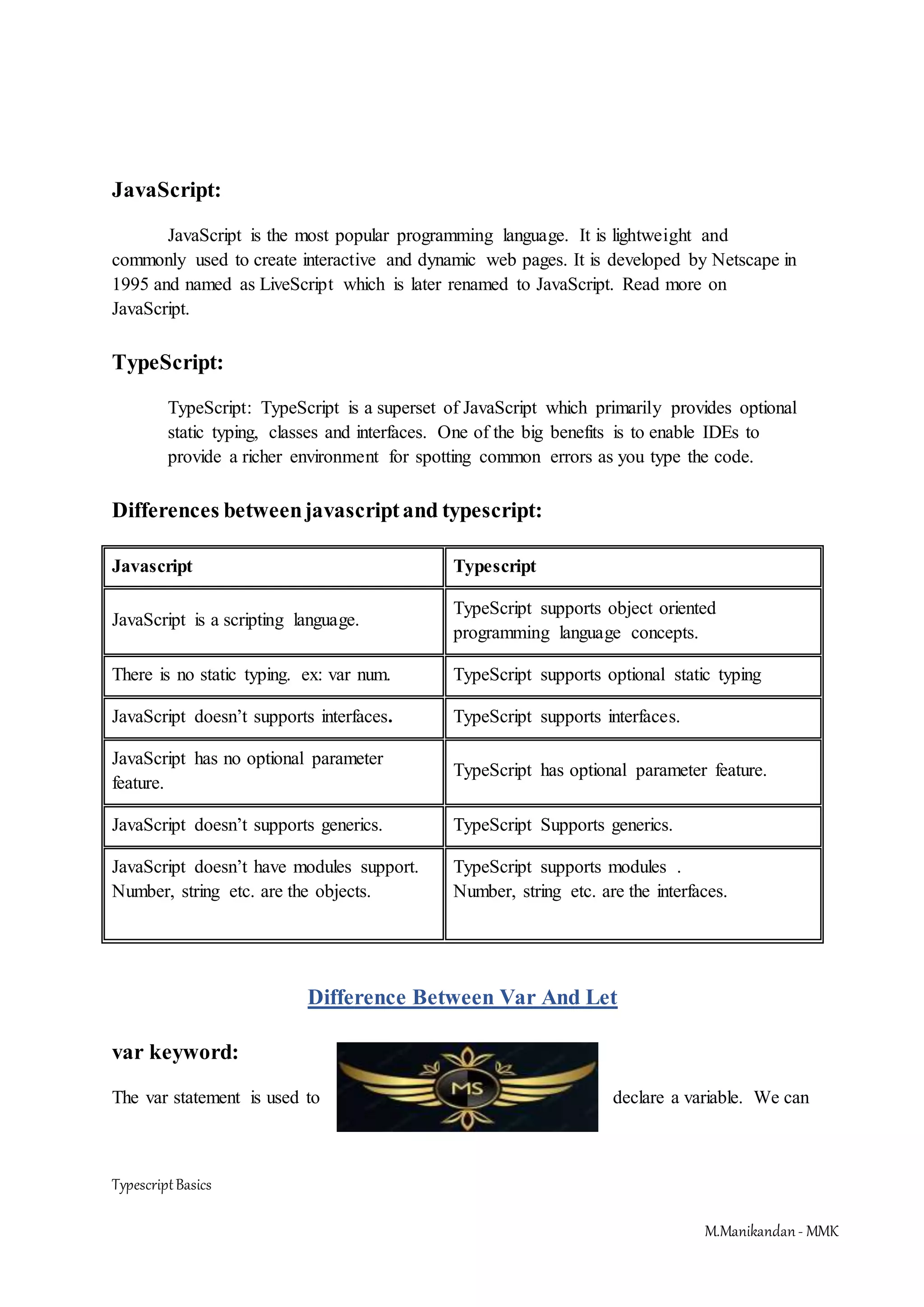
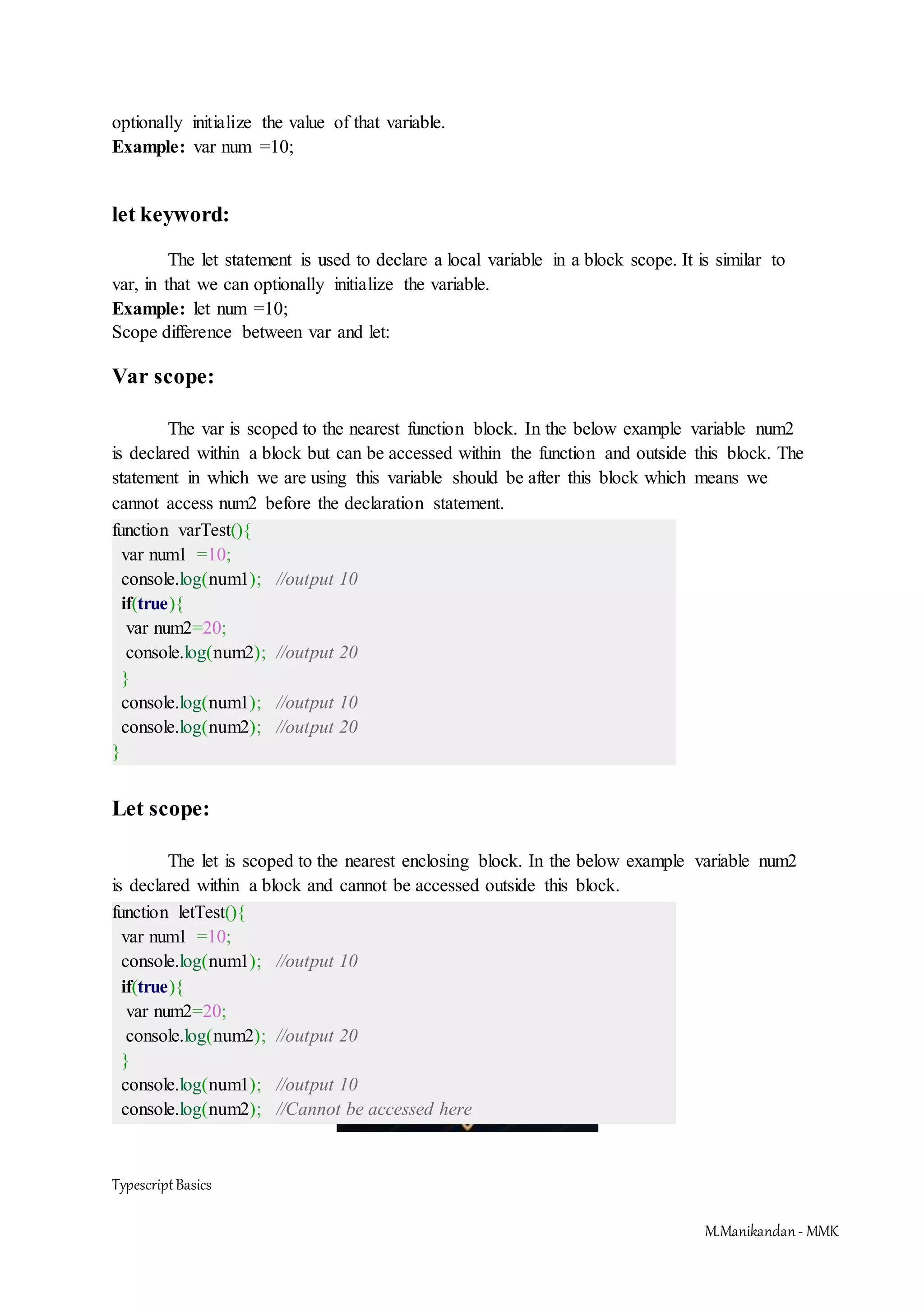
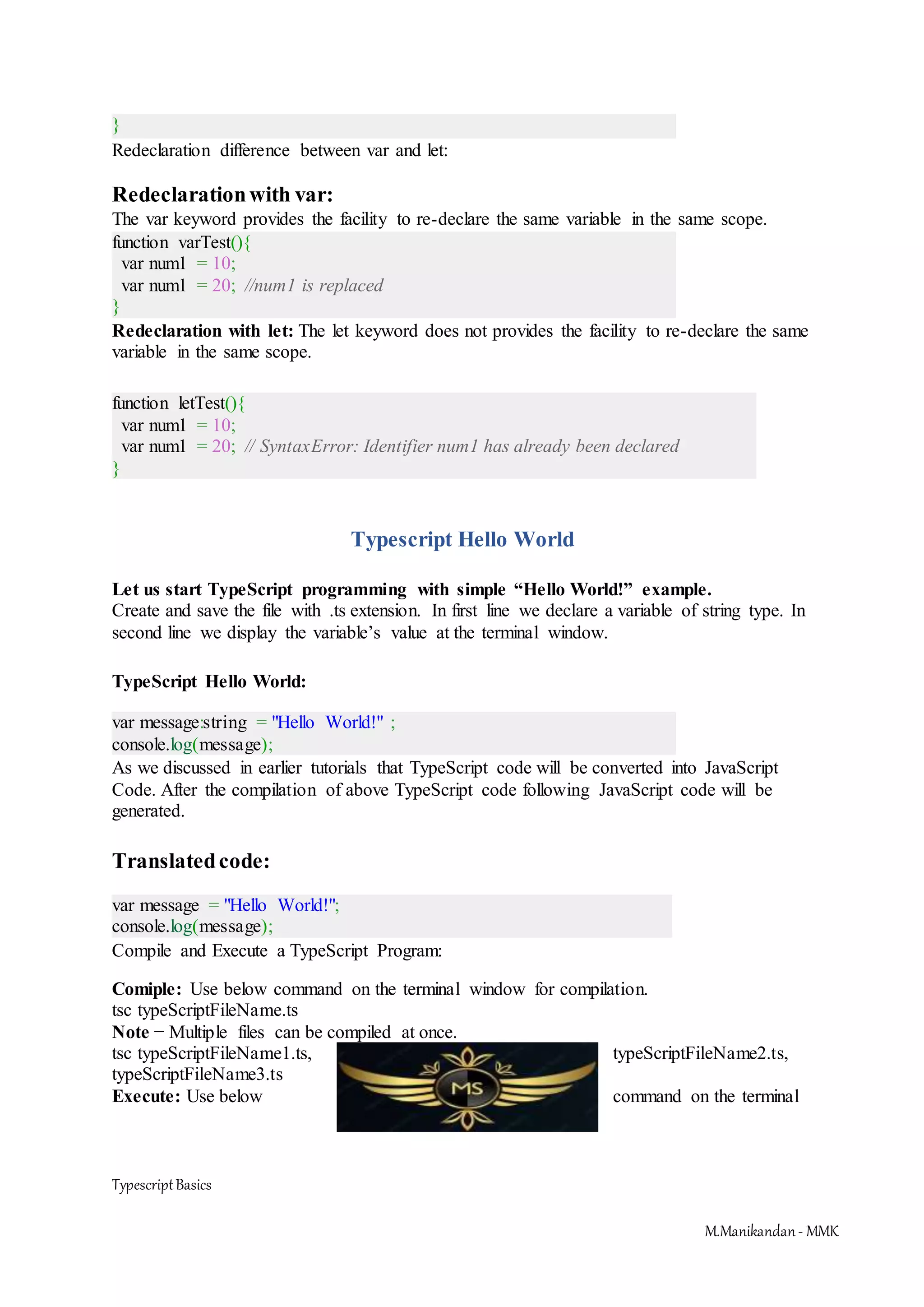

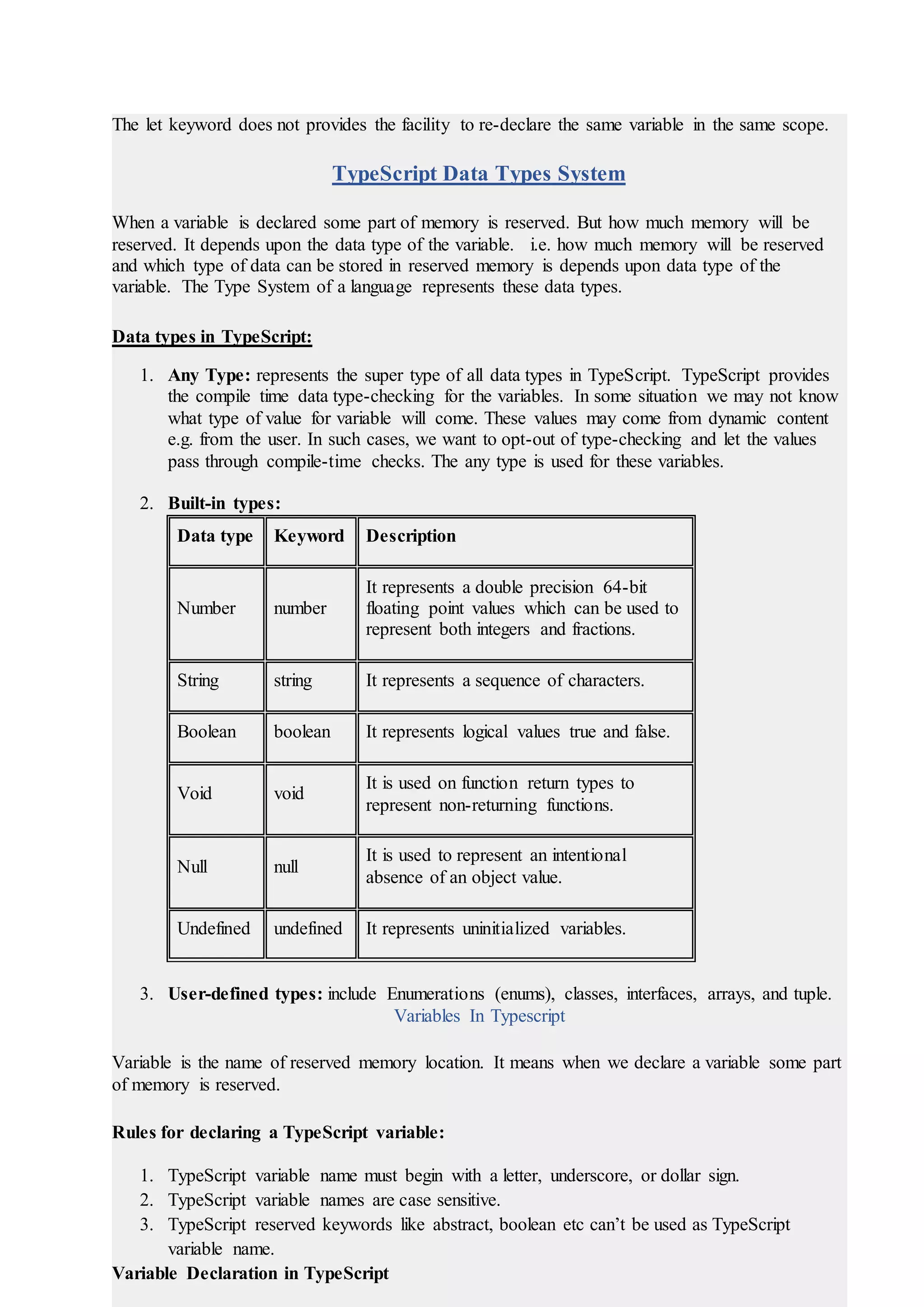
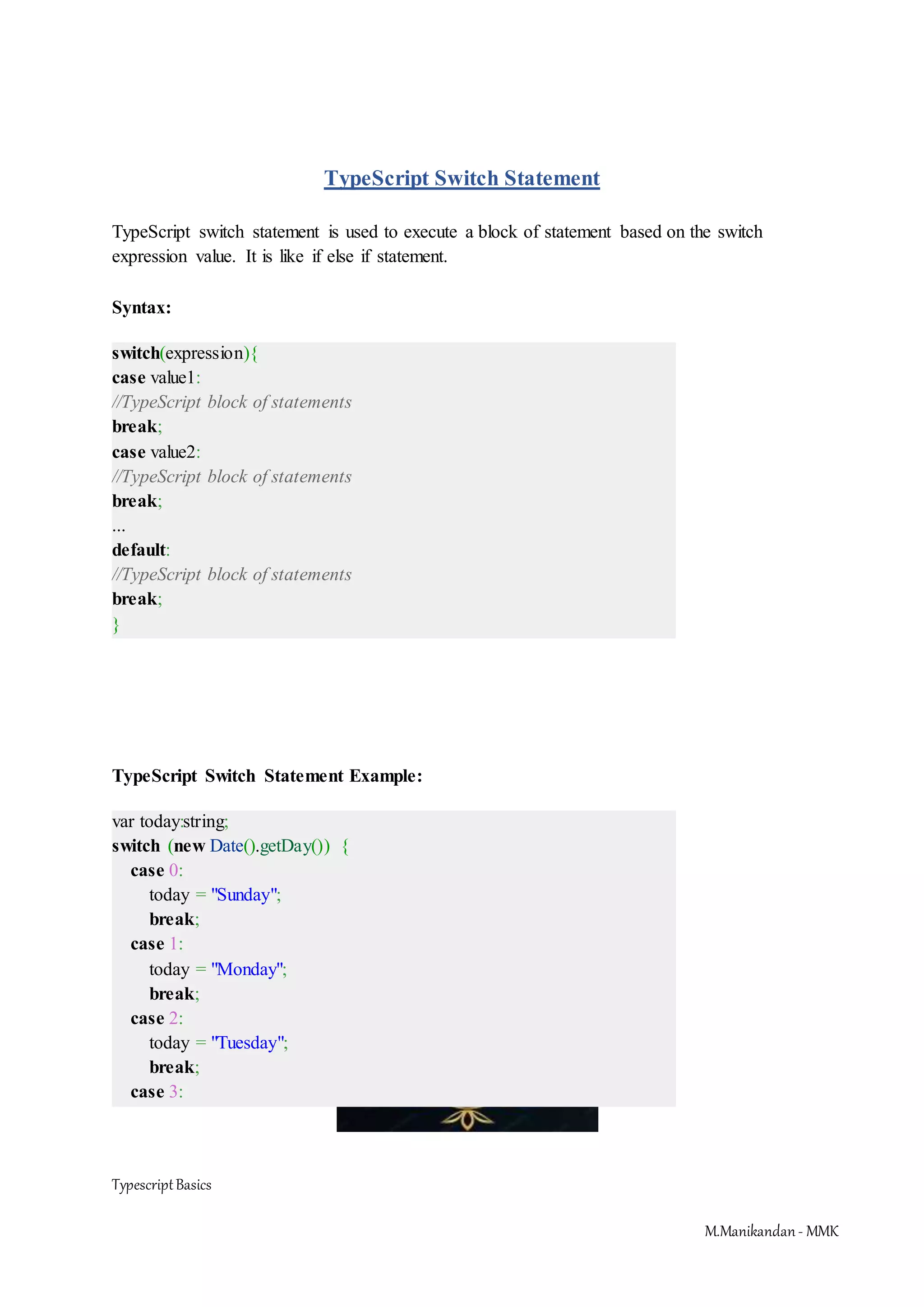
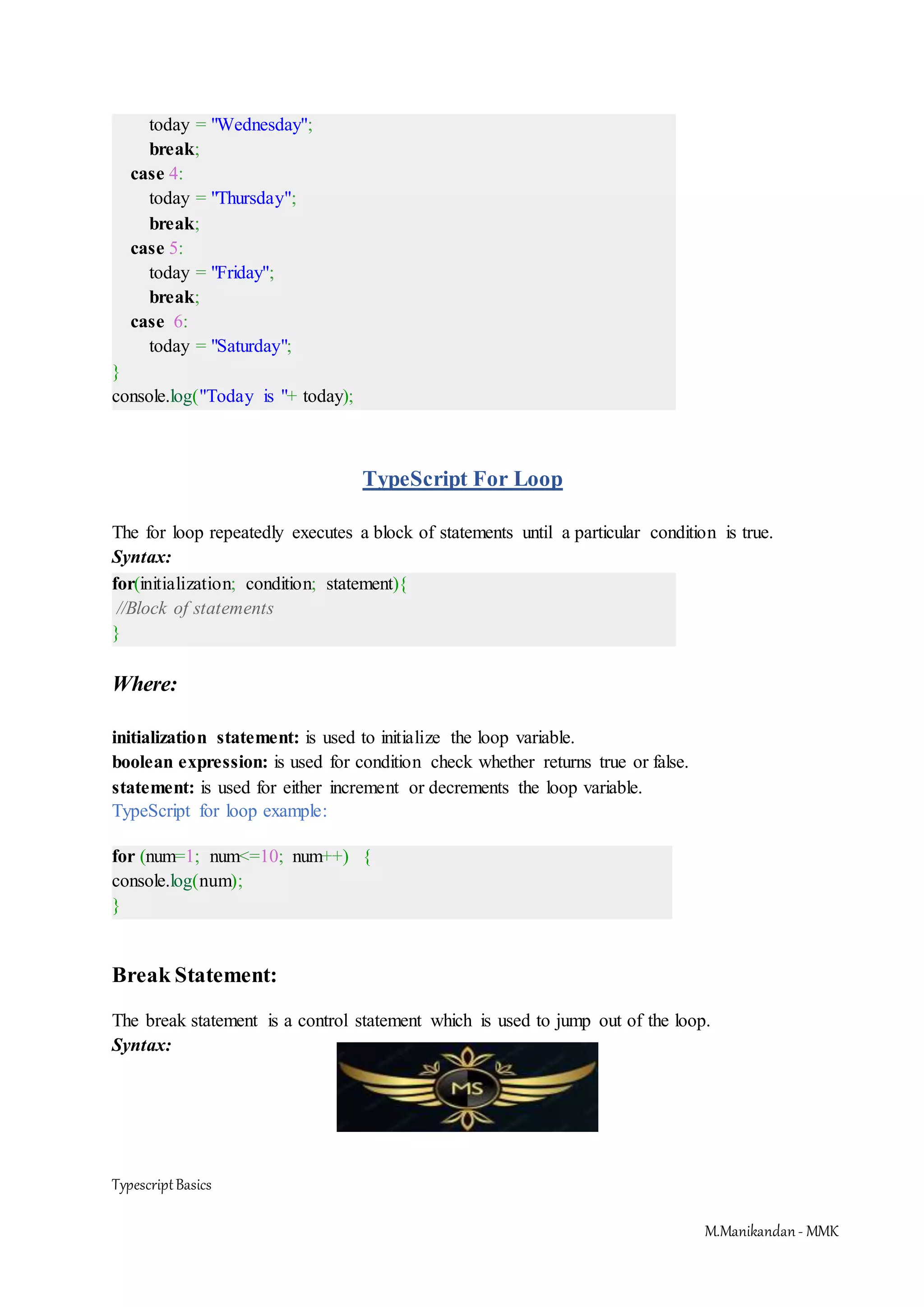
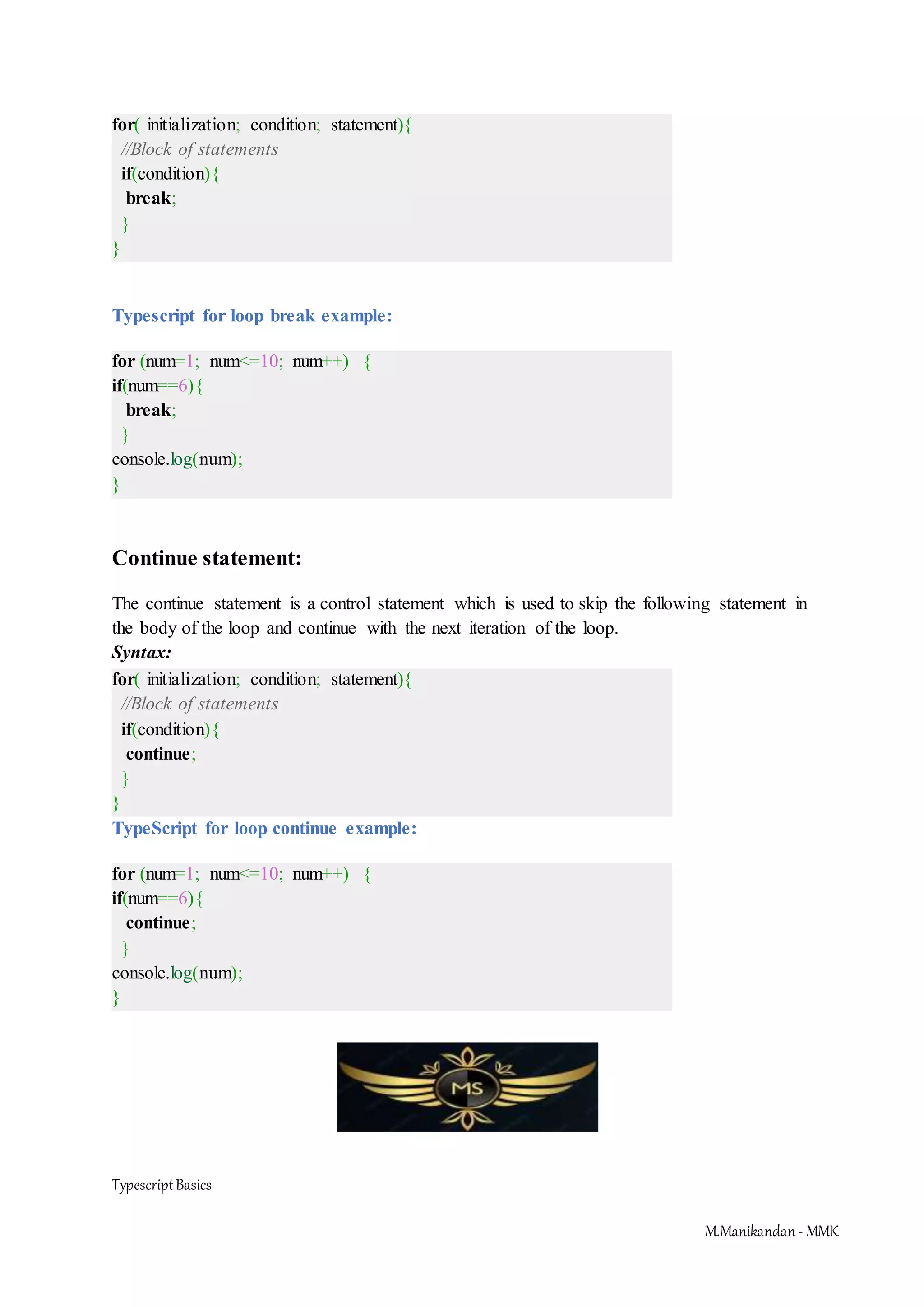
![TypescriptBasics M.Manikandan- MMK TypeScript For In Loop The for in loop is used to iterate the properties of an object. Syntax: for(property in object){ //Block of statements } TypeScript for in loop example: var person = {Fname:"Rajeev", Lname:"Johari", Age:40}; var perproperty; for (perproperty in person) { console.log(perproperty + ": " + person[perproperty ]); } TypeScript While Loop The while loop repeatedly executes a block of statements until a particular condition is true. It first check the condition and executes a block of statements if condition is true. Syntax: while(condition){ //Block of statements } TypeScript while loop example: var num:number=1; while (num<=10) { console.log(num); nu](https://image.slidesharecdn.com/typescripttutorial-211219084103/75/Typescript-Basics-10-2048.jpg)
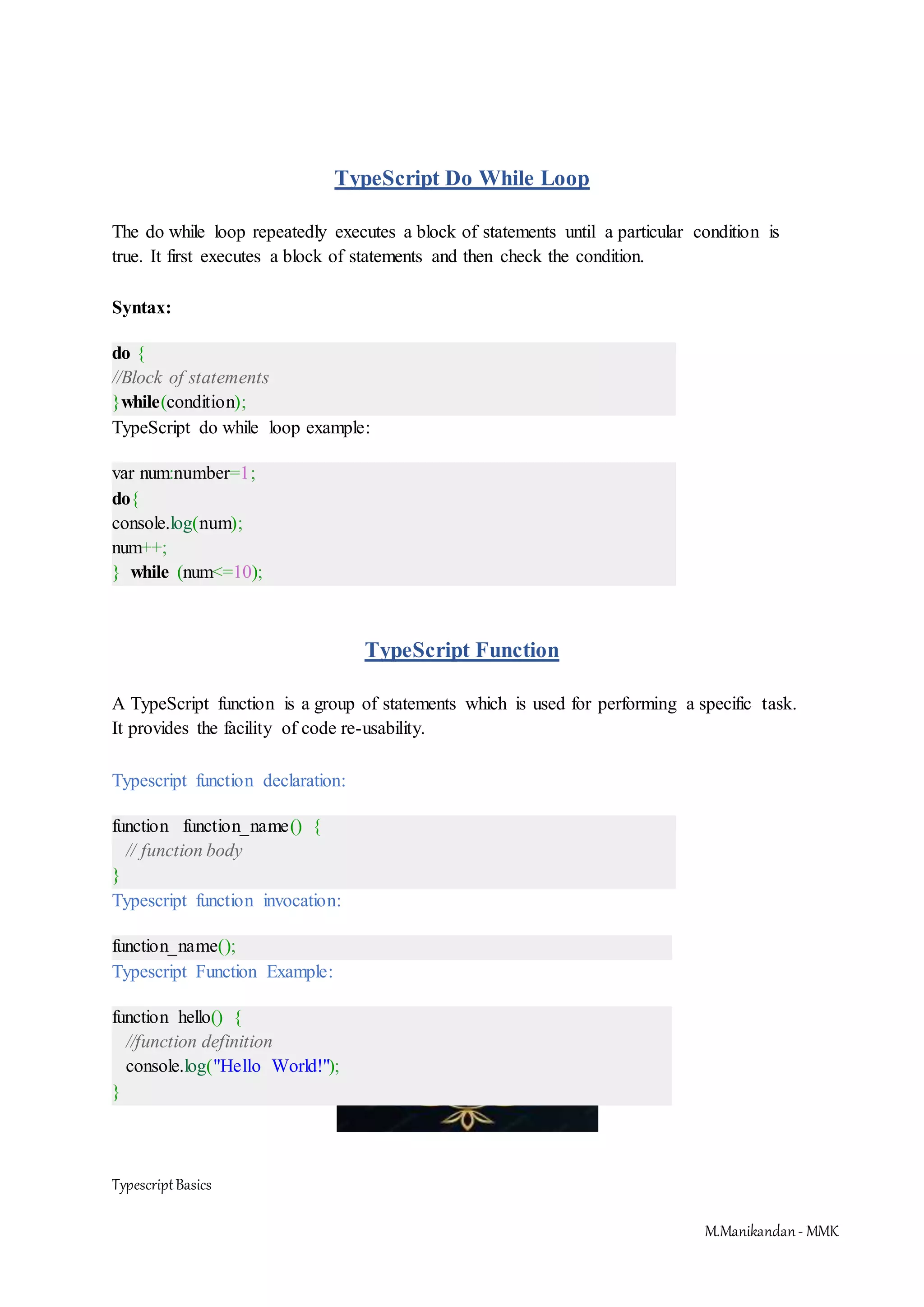
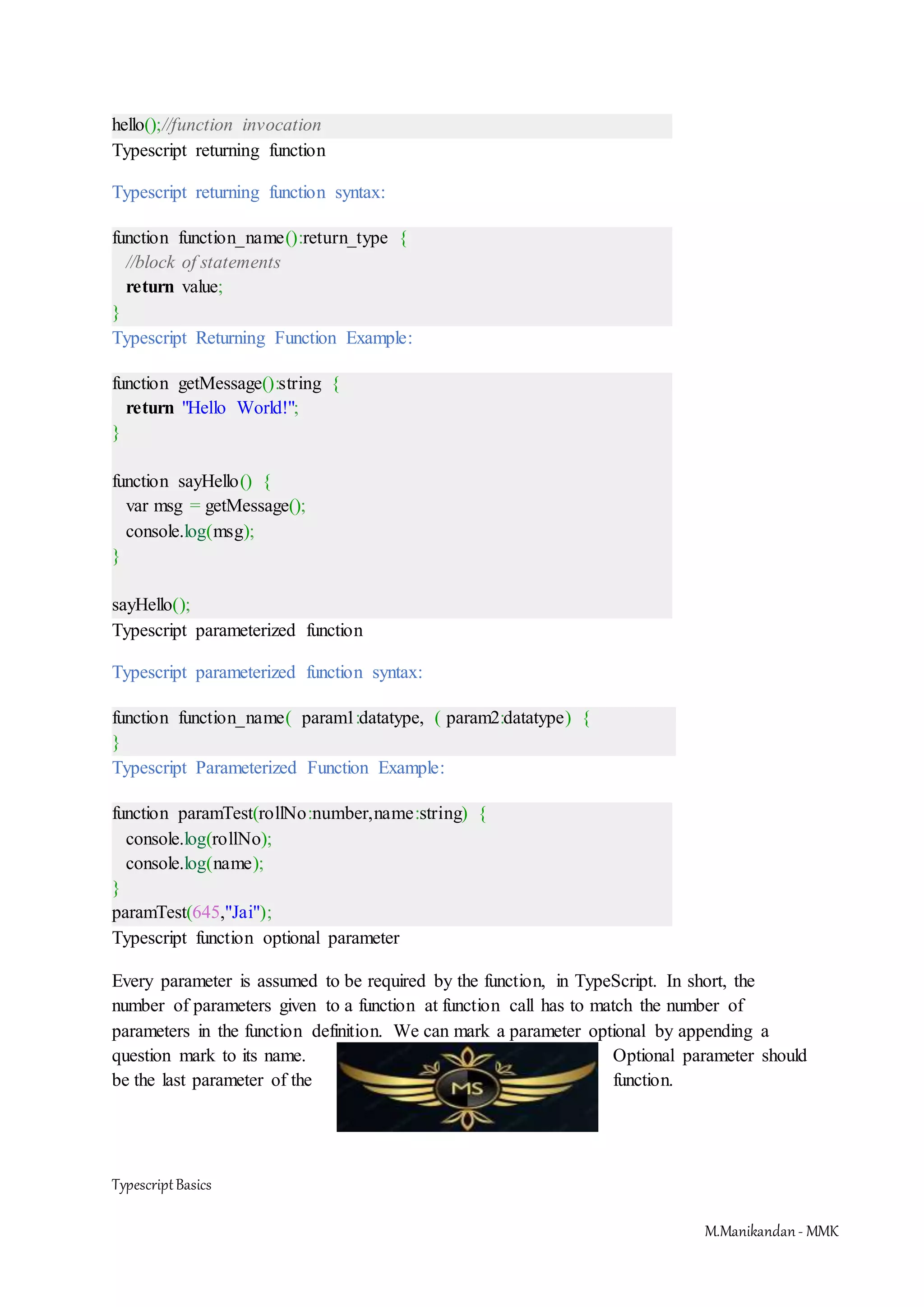
![TypescriptBasics M.Manikandan- MMK Typescript function optional parameter syntax: function function_name (param1:datatype, param2?:datatype) Typescript function optional parameter example: function dispDetails(fname:string,lname?:string) { console.log("Fisrt Name",fname); if(lname!=undefined) console.log("Last Name",lname); } dispDetails("Asmita"); dispDetails("Nidhi", "Gupta"); Typescript rest parameters When we talked about optional and default parameters all have one common thing, they talk about one parameter at a time. Sometimes we need multiple parameters as a group. TypeScript rest parameters used in such situations. They are act as the placeholder for multiple arguments of the same type. Use the ellipsis (…) as the prefix of rest parameter. Typescript rest parameters syntax: function function_name (…param1:datatype) Typescript rest parameters example: function showNames(...names:string[]) { for(var i = 0;i<names.length;i++) { console.log(names[i]); } } showNames("Rajeev","Gunjan","Vikram","Asmita"); showNames("Mahesh", "Jai", "Narender", "Vishal", "Hemant"); Typescript default parameters The TypeScript default-initialized parameters are used to set a default value to the parameter if the user does not provide one. Note: We cannot declare a parameter optional and default at the same time.](https://image.slidesharecdn.com/typescripttutorial-211219084103/75/Typescript-Basics-13-2048.jpg)
![TypescriptBasics M.Manikandan- MMK Typescript default parameters syntax: function function_name(param1:datatype,param2:datatype = default_value) Typescript default parameters example: function displayDetails(name:string,sport:string = "Cricket") { console.log("Name: " +name + ", Sport: "+ sport); } displayDetails("Jai"); displayDetails("Vivek","Football"); A function created without function name is known as anonymous function. Typescript anonymous function syntax: Typescript anonymous function syntax: var result = function( [arguments] ) { ... } Typescript anonymous function example: var sayHello = function() { return "Hello World!"; } console.log(sayHello()); Typescript anonymous function with parameters example: var sayHello = function(name:string) { return "Hello "+name; } console.log(sayHello("Jai")); Typescript function constructor TypeScript provides the facility to create a function with the built-in JavaScript constructor called Function (). Typescript function constructor syntax: var result = new Function( [arguments] ) { ... } Typescript function constructor example: var myFunction = new Function("num1", "num2", "return num1 + num2"); var result = myFunction(10, 15); console.log(result);](https://image.slidesharecdn.com/typescripttutorial-211219084103/75/Typescript-Basics-14-2048.jpg)
![TypescriptBasics M.Manikandan- MMK Arrow / Lambda function: Typescript lambda or arrow functions are used to represent anonymous functions. Parts of Arrow / Lambda function: Parameters Arrow notation/lambda notation (=>) Statements Typescript Arrow / Lambda function syntax: ( [param1, parma2,…param n] )=>statement; Typescript Arrow / Lambda function example: var calculateSquare = (num:number)=> { num = num * num; console.log(num); } calculateSquare(10); Ways to implement method overloading: Method overloading means more than one methods with the same name but different parameters. Parameters can be differing in types, numbers or order. Ways to implement method overloading: Parameters differ in types. function showDetails(s1:string):void; function showDetails(num1:number):void; Parameters differ in number. function showDetails(s1:string):void; function showDetails(x:string, y:string):void; Parameters differ in order function showDetails(num1:numer, s1:string):void; function showDetails(s2:string, num2:number):void; Typescript function overloading example: function showDetails(name:string):void{ console.log(name); }](https://image.slidesharecdn.com/typescripttutorial-211219084103/75/Typescript-Basics-15-2048.jpg)
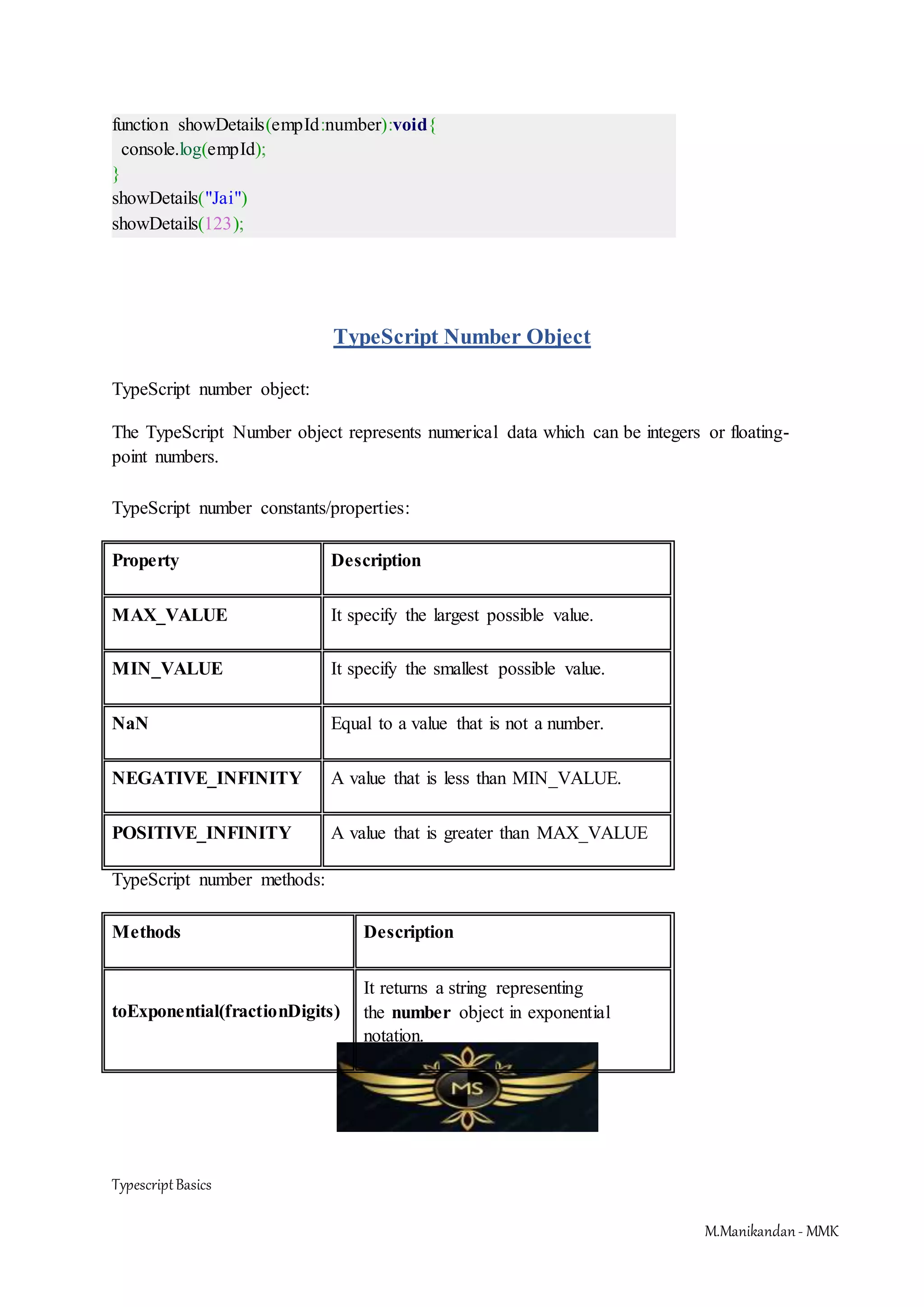
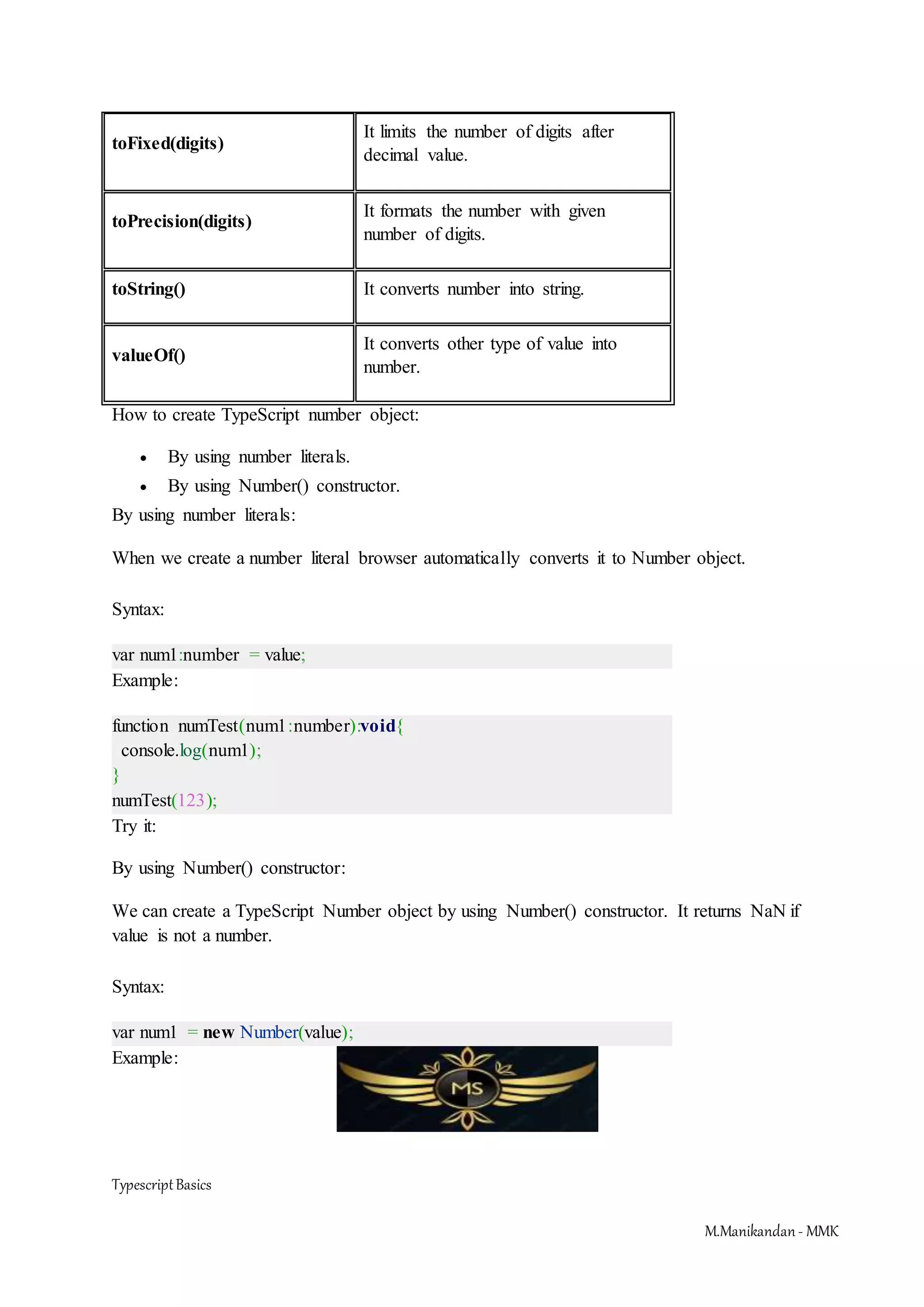
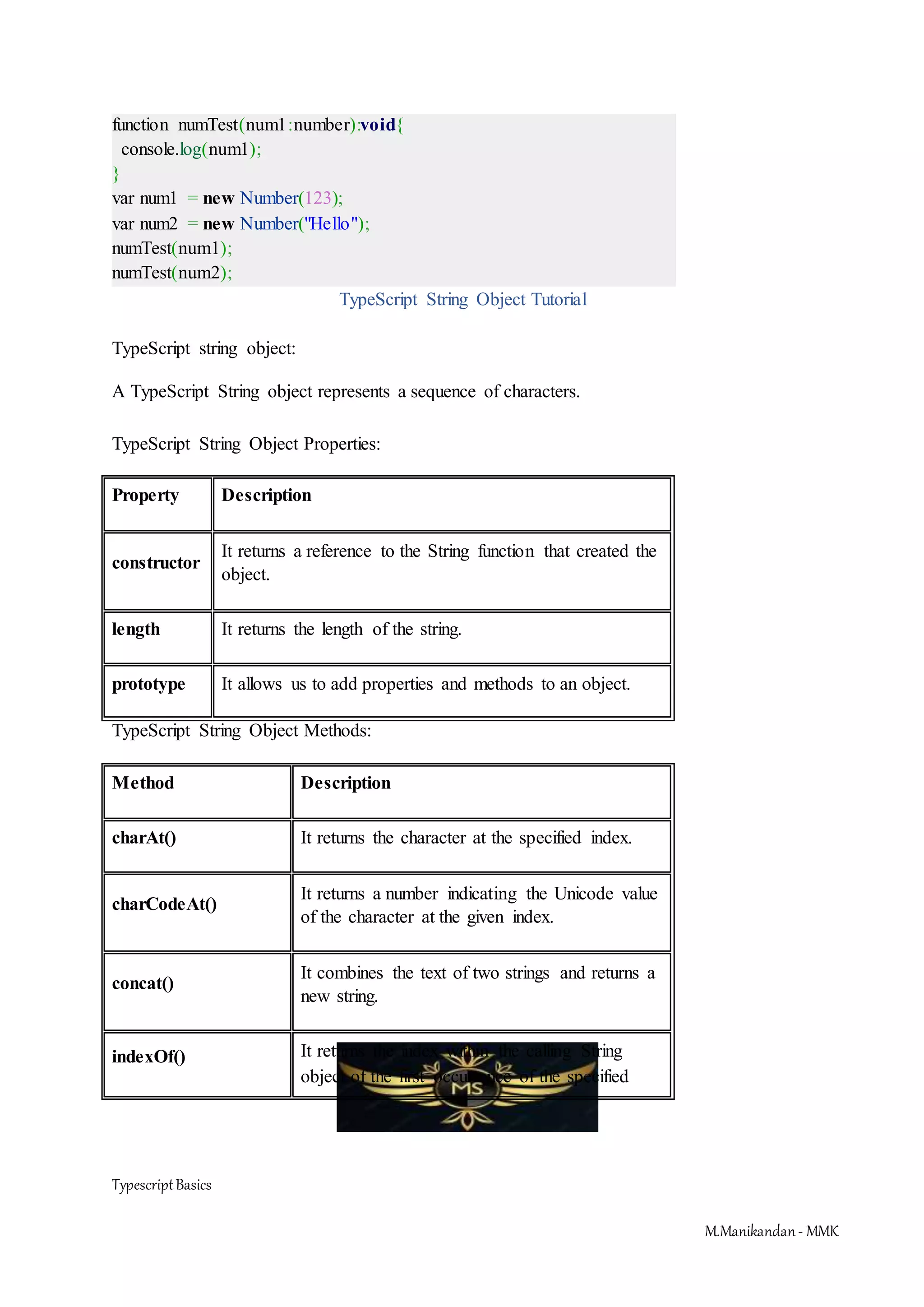
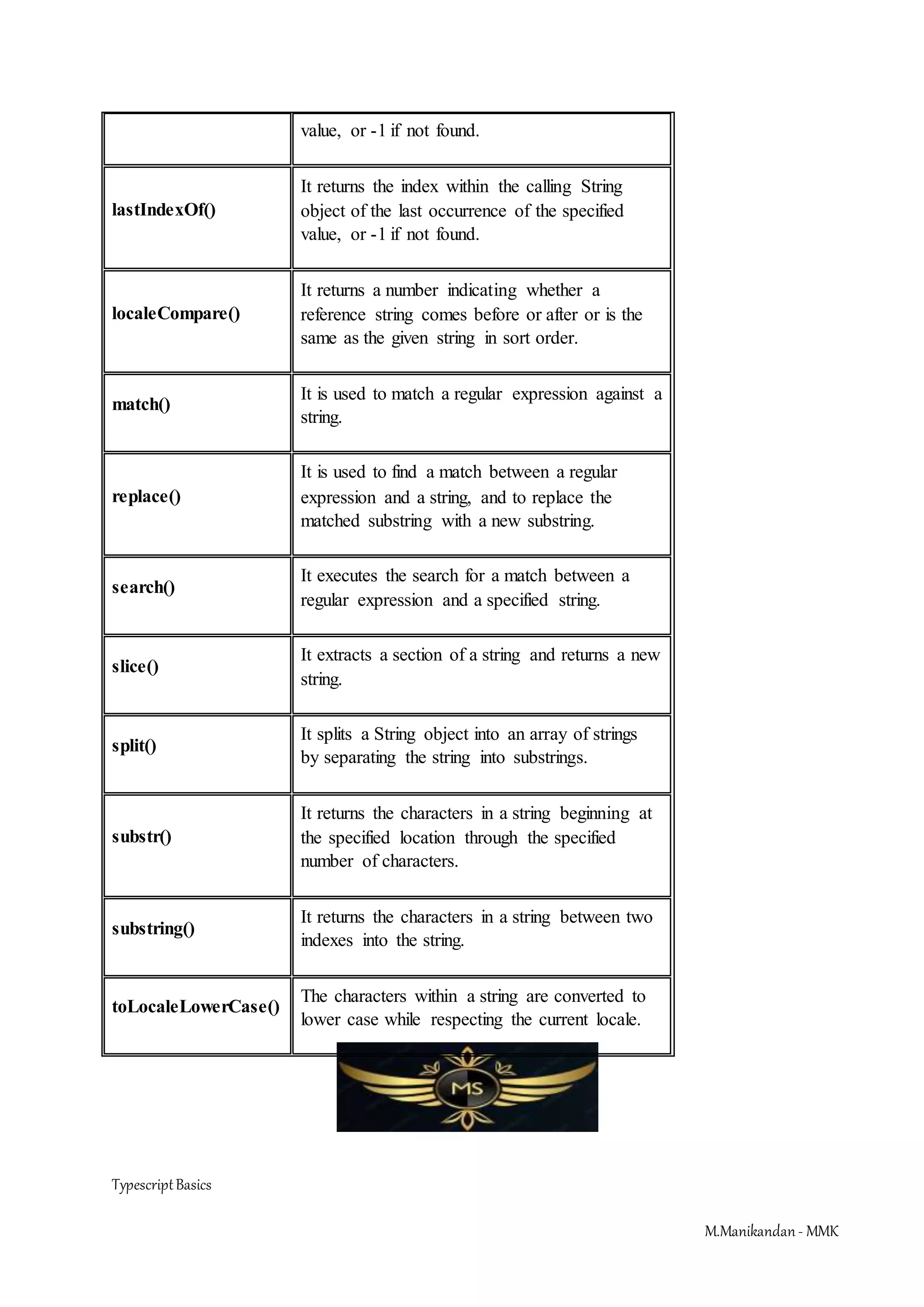
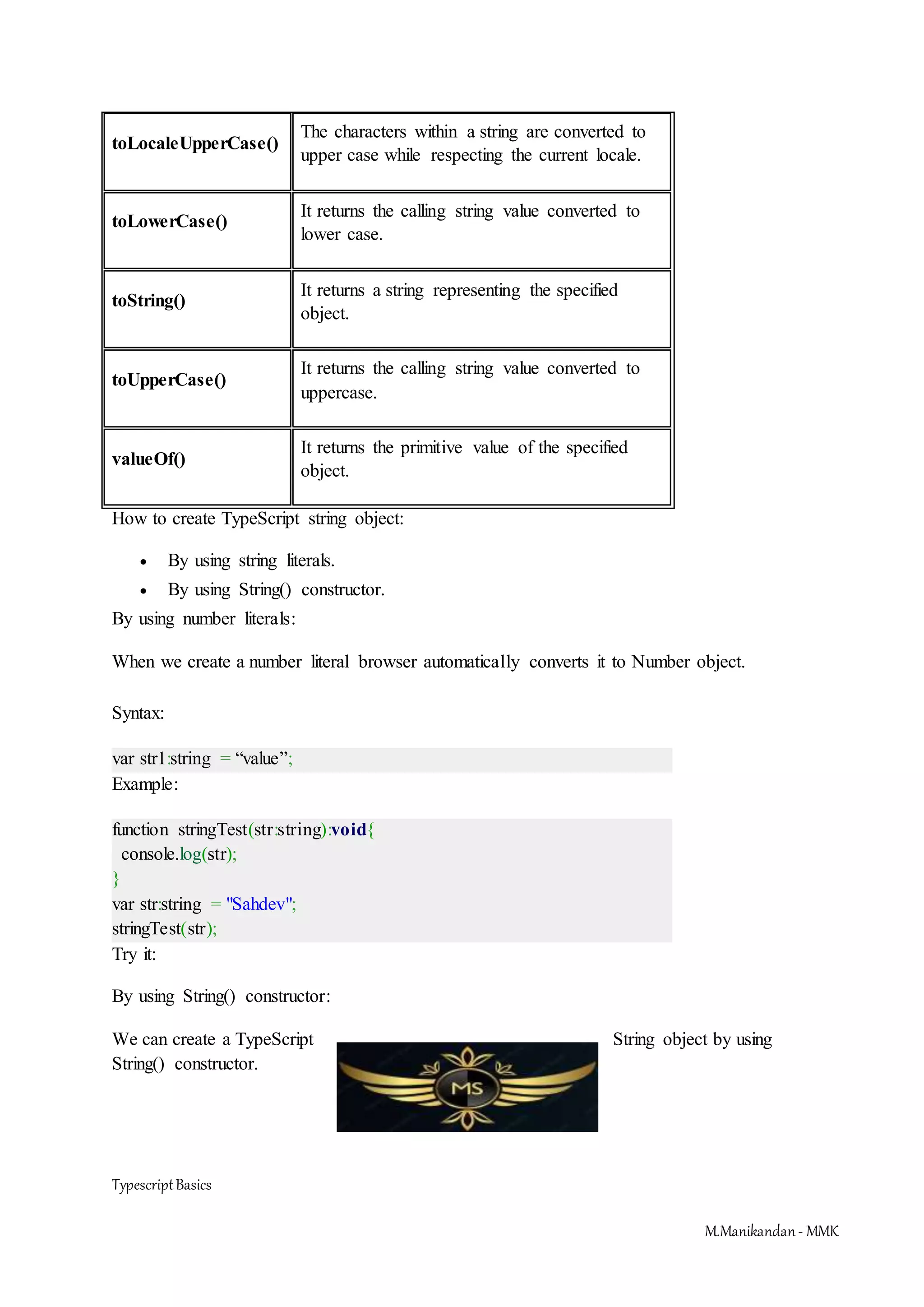
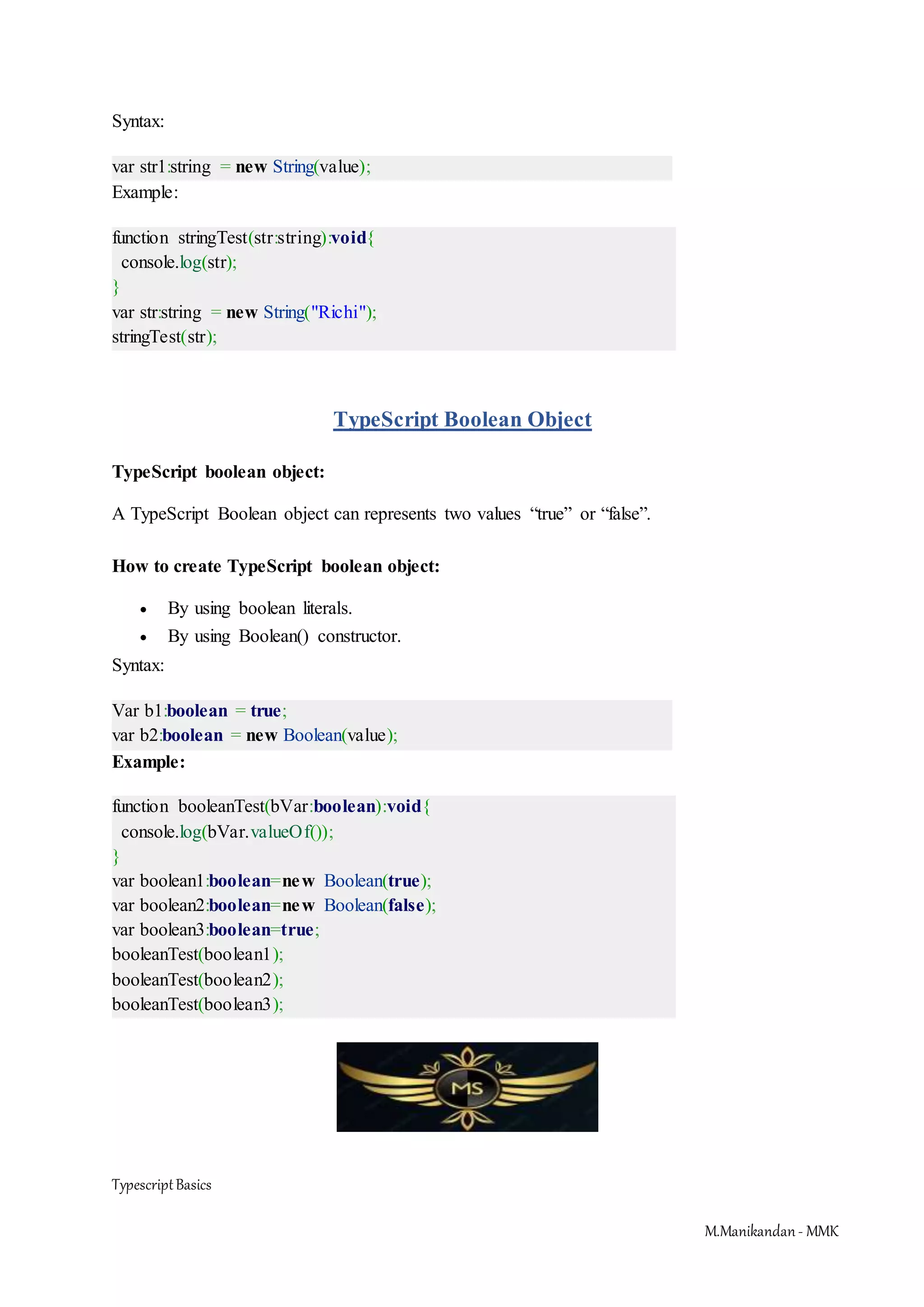
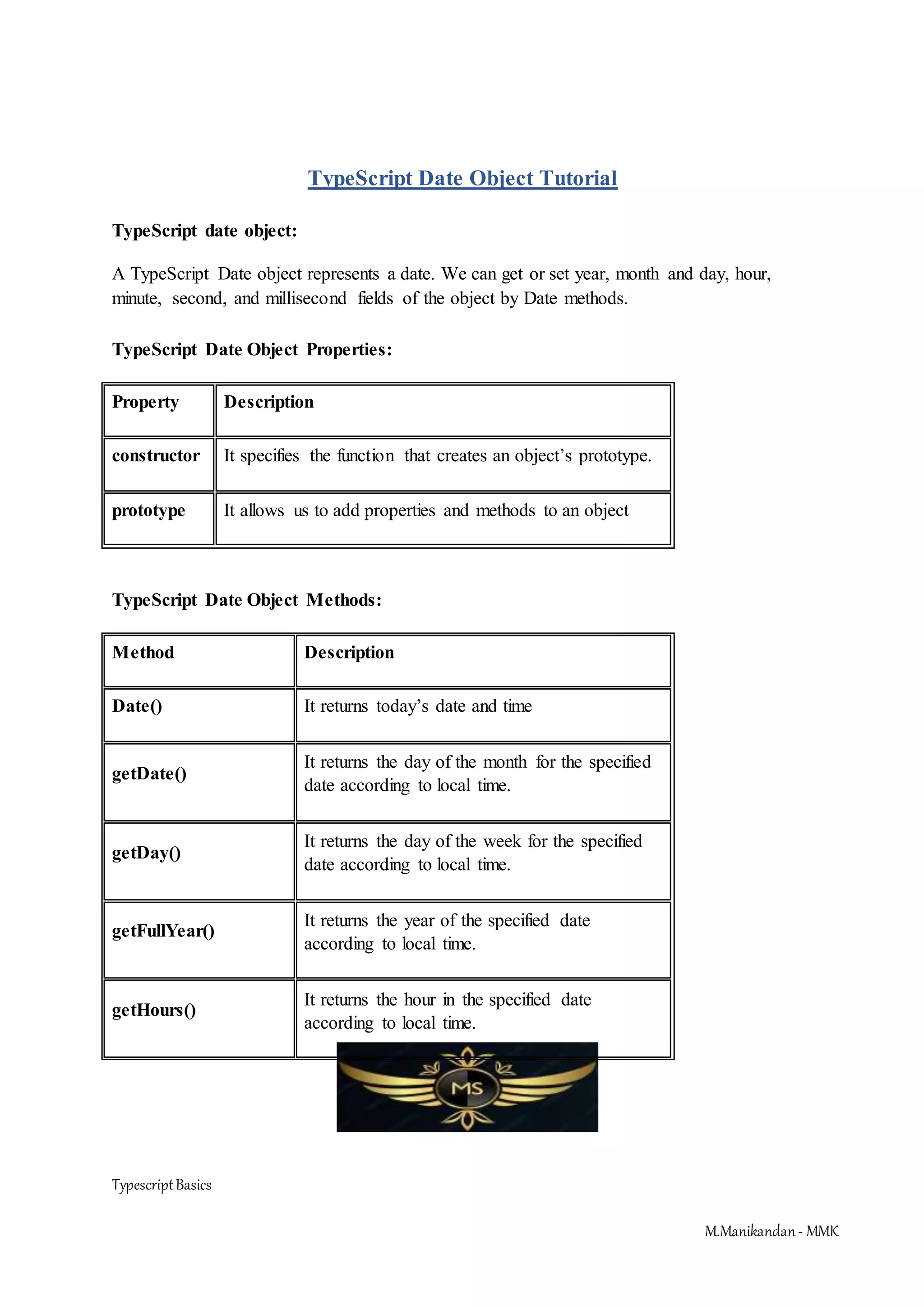
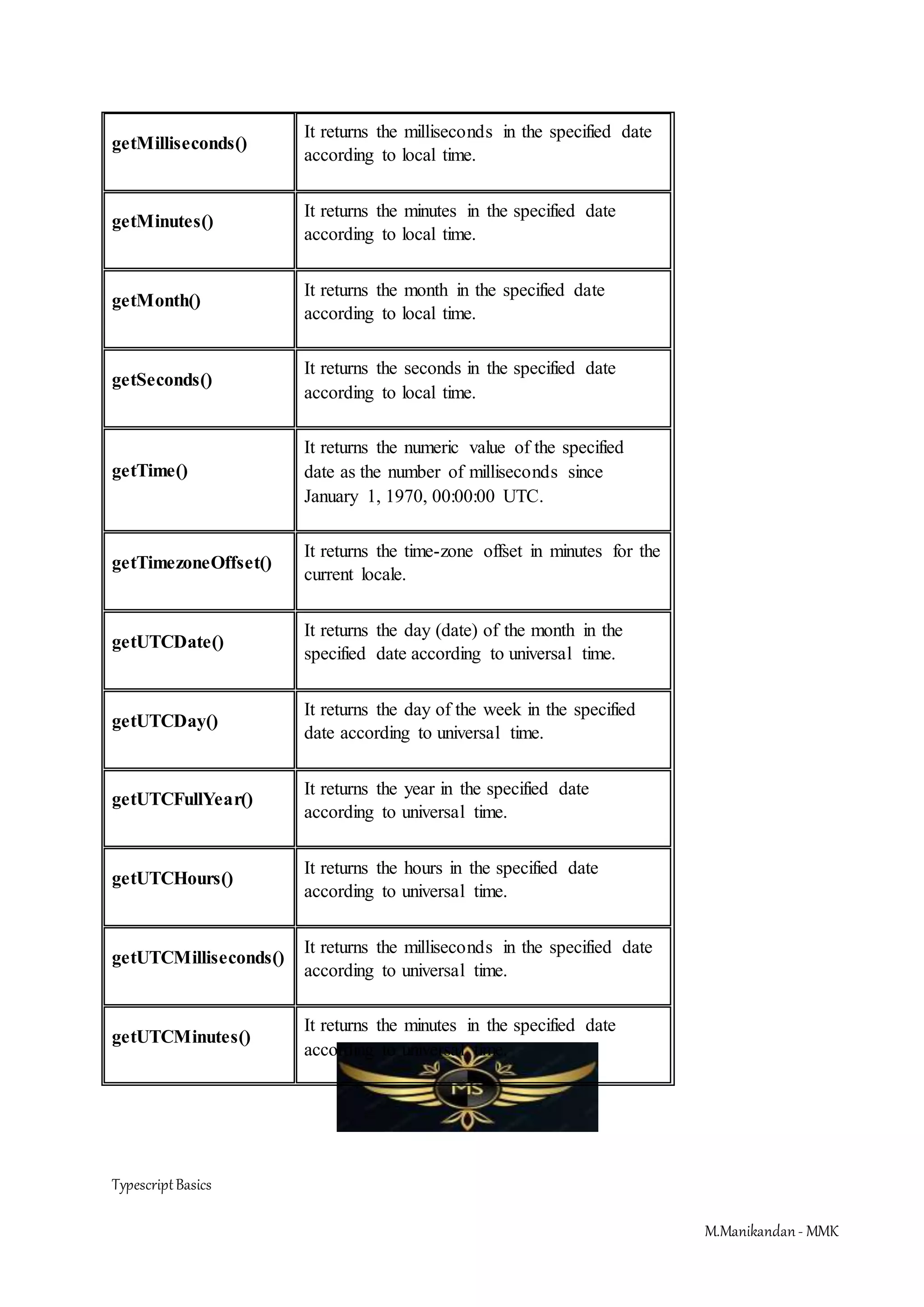
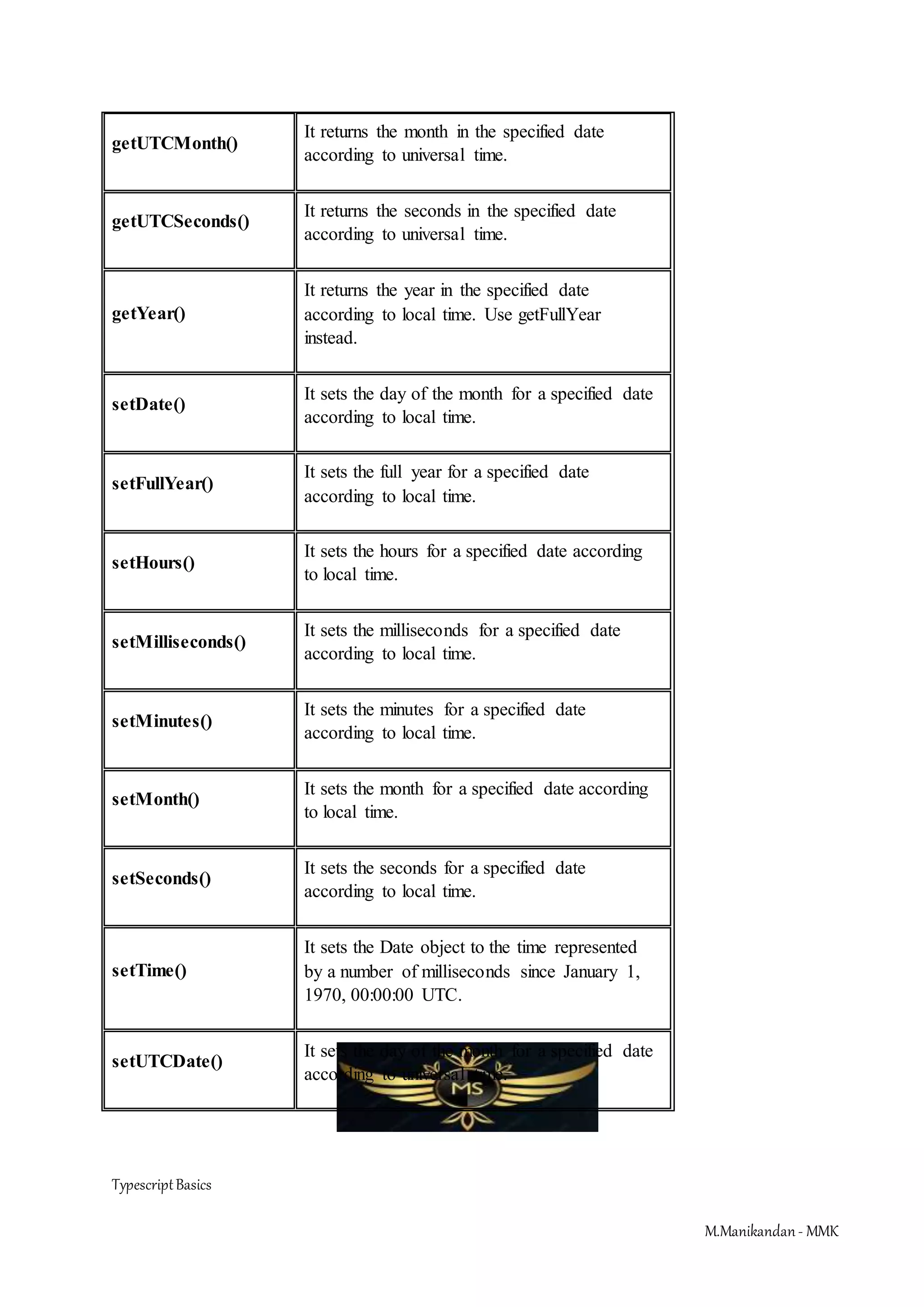
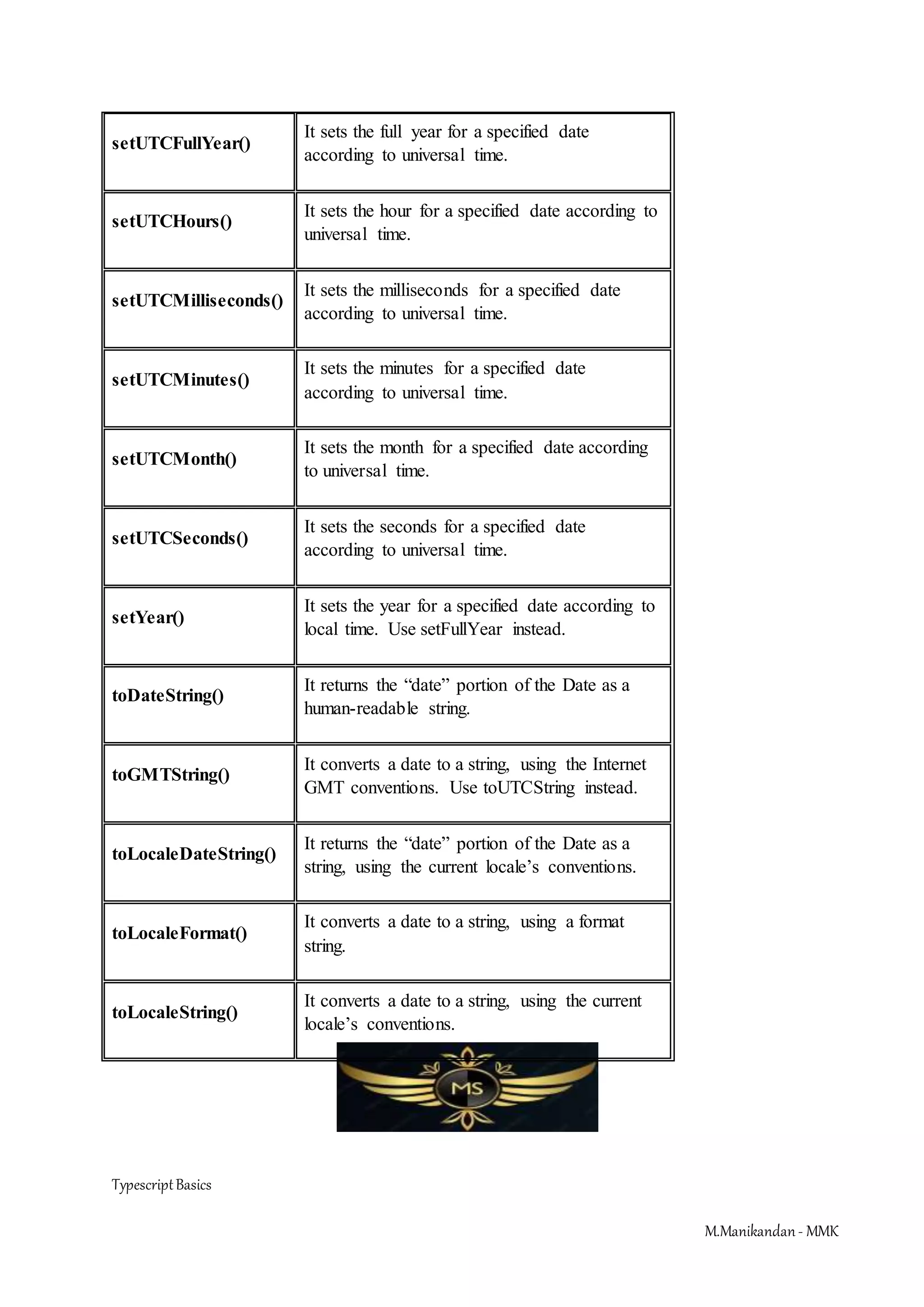
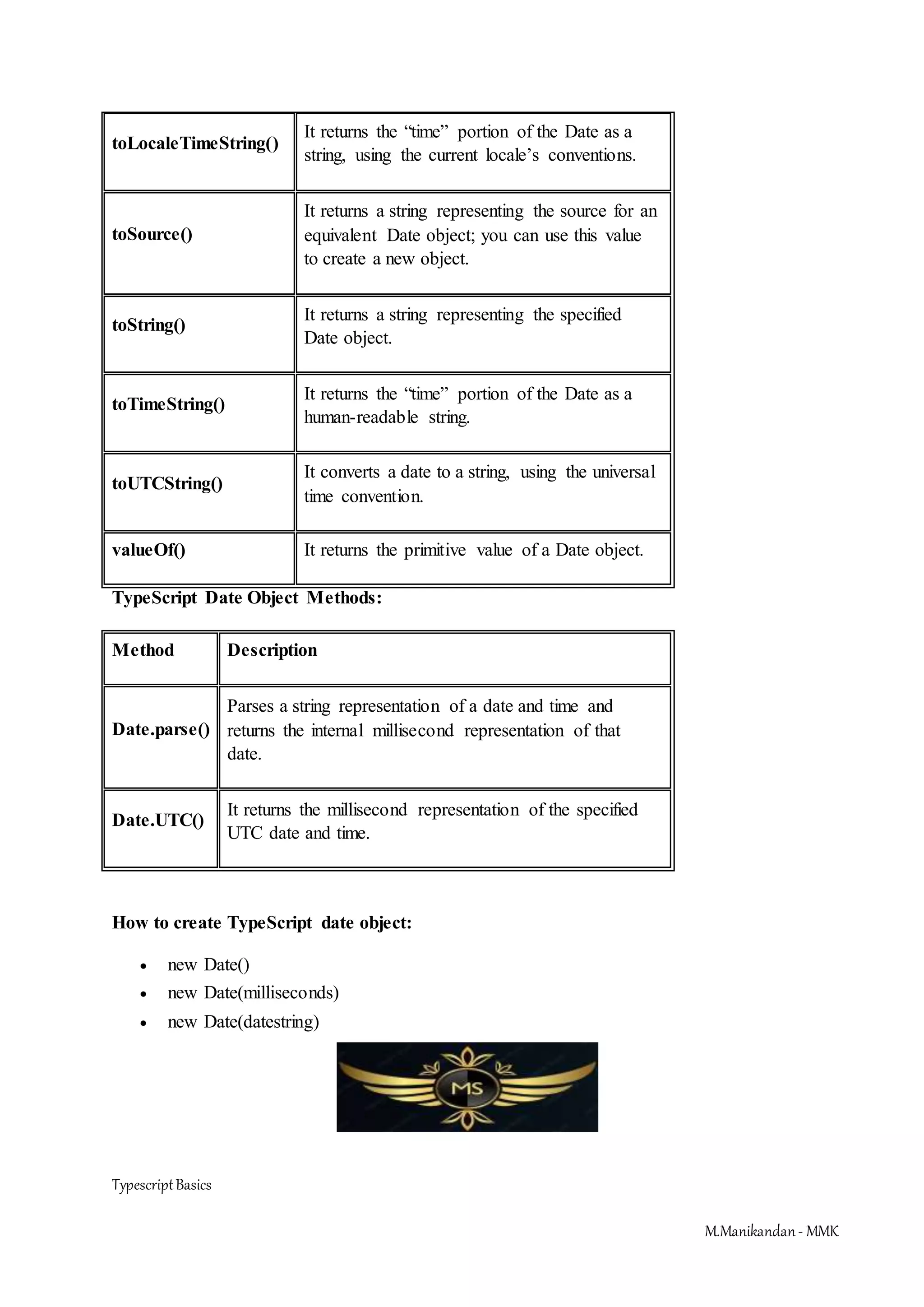
![TypescriptBasics M.Manikandan- MMK new Date(year,month,date[,hour,minute,second,millisecond ]) Example: function dateTest(date:Date):void{ var hours=date.getHours(); var minutes=date.getMinutes(); var seconds=date.getSeconds(); console.log("Current Time: "+hours+":"+minutes+":"+seconds); } var date=new Date(); dateTest(date); TypeScript Math Object TypeScript math object: A TypeScript Math object provides no. of properties and methods for performing mathematical operations. Math is not a constructor and all the properties and methods of Math are static. TypeScript Math Object Properties: Property Description E Euler’s constant and the base of natural logarithms, approximately 2.718. LN2 Natural logarithm of 2, approximately 0.693. LN10 Natural logarithm of 10, approximately 2.302. LOG2E Base 2 logarithm of E, approximately 1.442. LOG10E Base 10 logarithm of E, approximately 0.434. PI Ratio of the circumference of a circle to its diameter, approximately 3.14159.](https://image.slidesharecdn.com/typescripttutorial-211219084103/75/Typescript-Basics-27-2048.jpg)
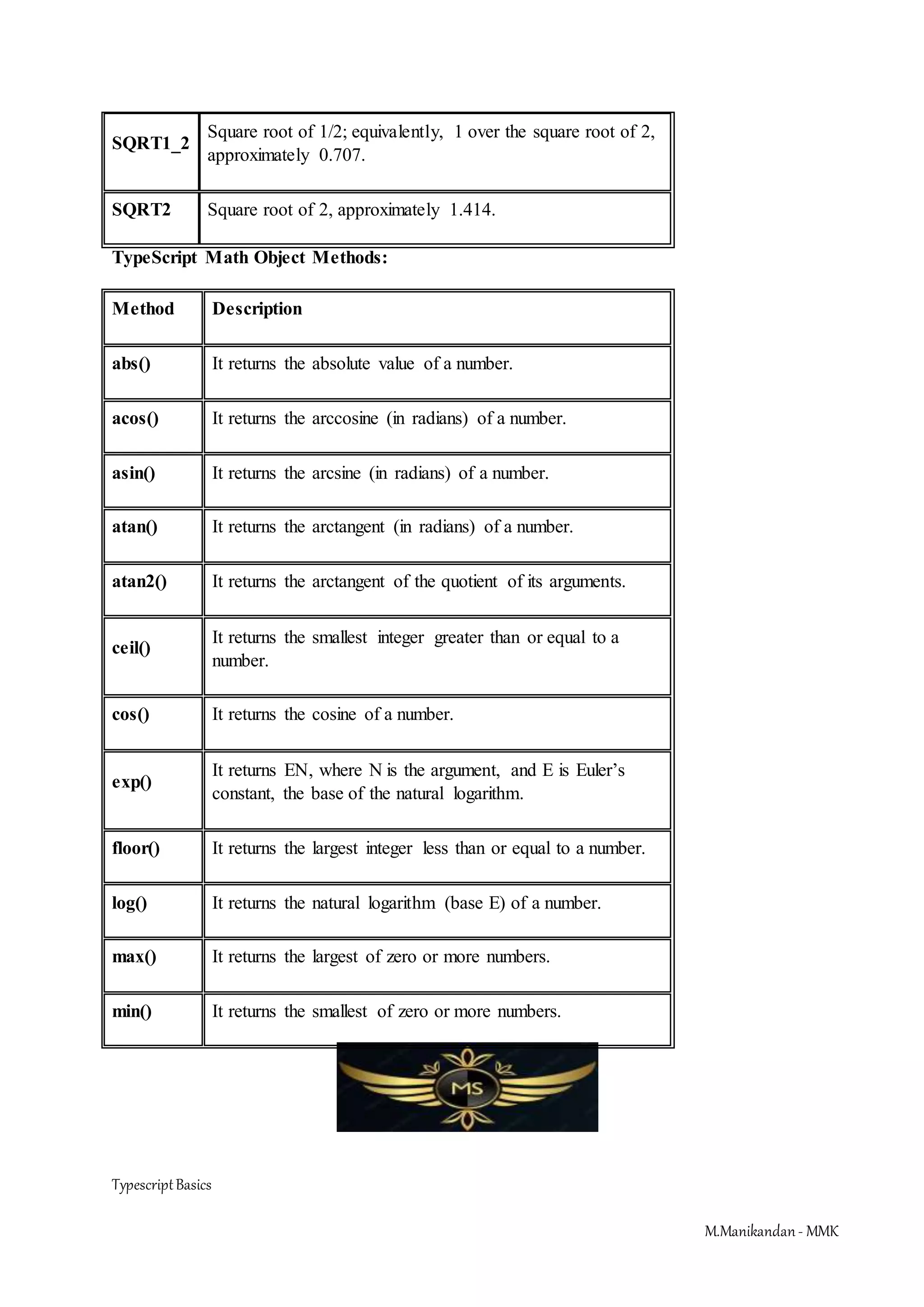
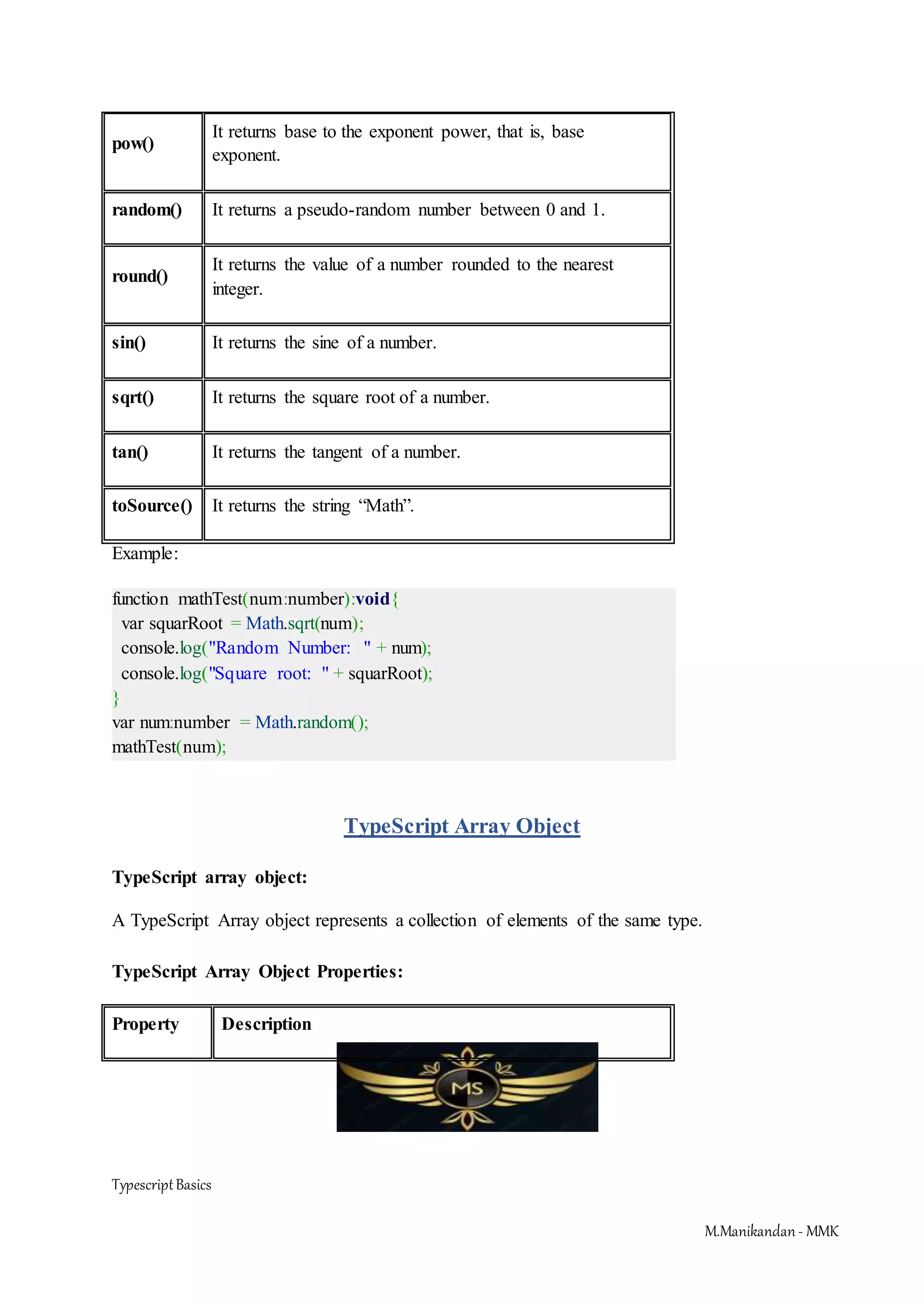
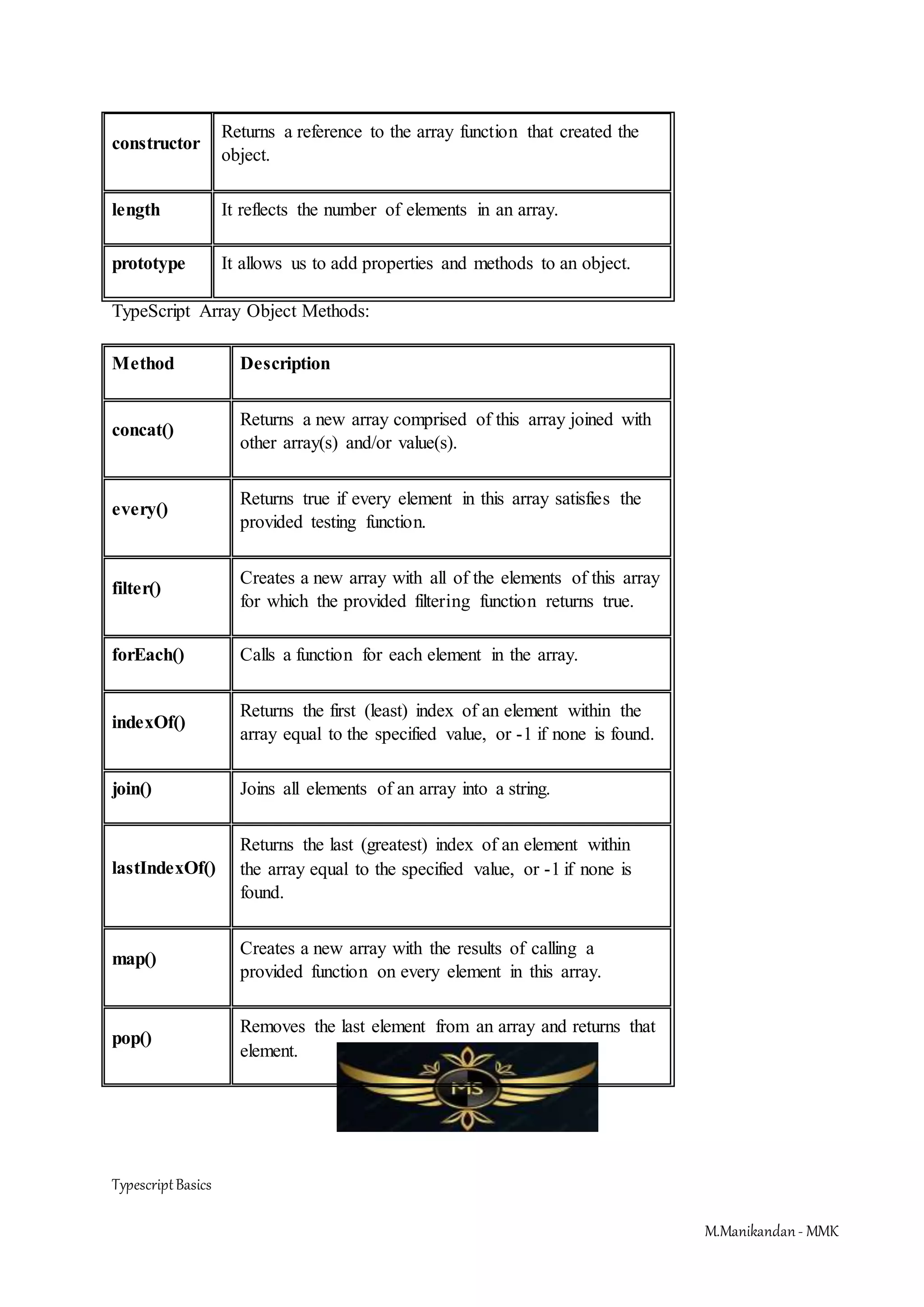
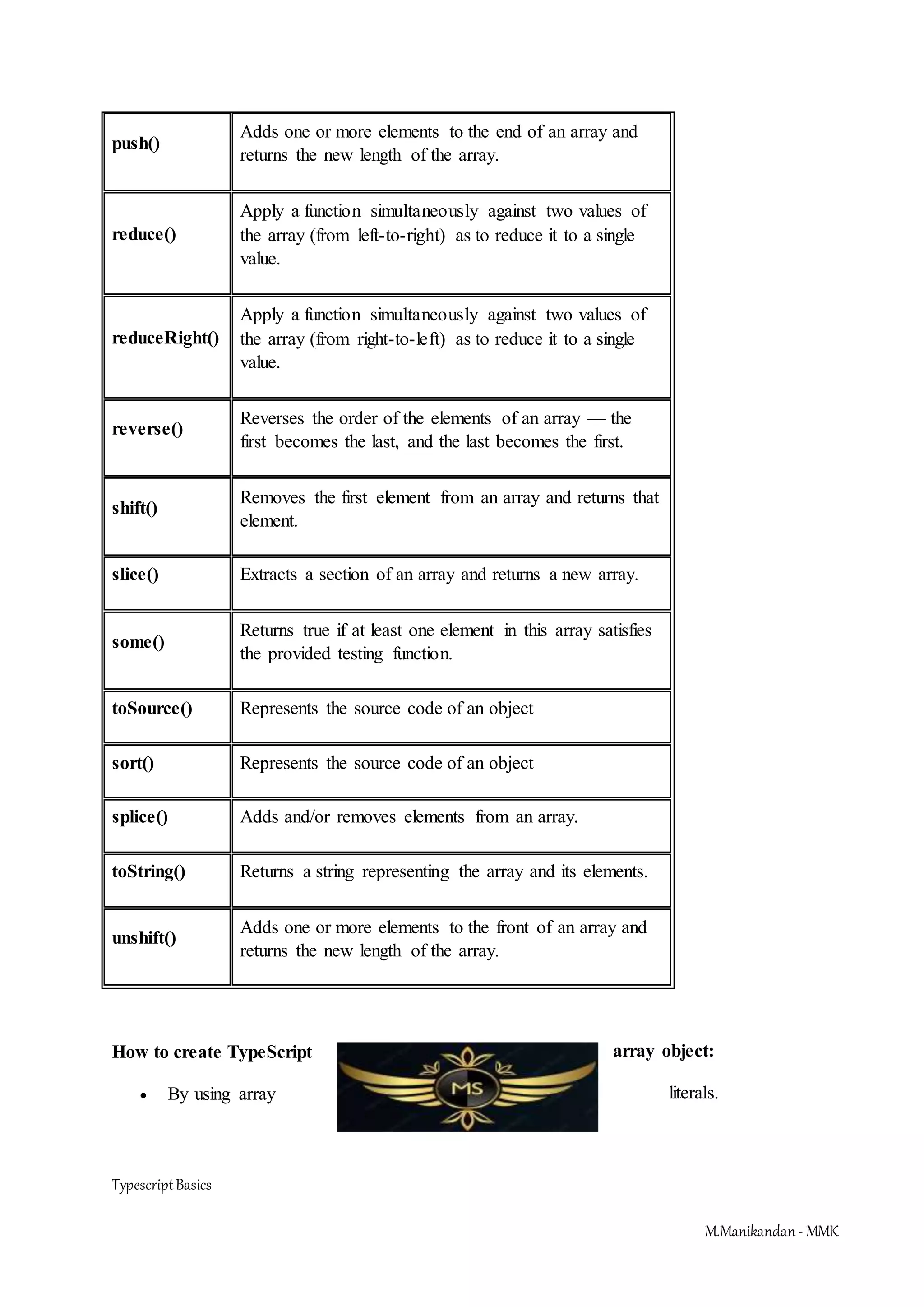
![TypescriptBasics M.Manikandan- MMK By using Array() constructor. By using array literals: Using an array literal is the simplest way to create a TypeScript Array. Syntax: var array1:string[] = ["element1","element2","elementN"]; Example: function arrayTest(names:string):void{ for (i=0;i<names.length;i++){ console.log(names[i]); } } var names:string[] = ["Bharat","Sahdev","Richi","Harish","Bharti","Deepika","Shaveta"]; arrayTest(names); By using Array() constructor: We can create a TypeScript Array object by using Array() constructor. Syntax: var array1 = new Array(“element1”, “element2”, “elementN”); Example: function arrayTest(names:string):void{ for (i=0;i<names.length;i++){ console.log(names[i]); } } var names:string[] = new Array("Jai","Vivek","Mahesh","Narender","Vishal","Hemant"); arrayTest(names); TypeScript Tuple TypeScript tuples: Typescript tuple represents a heterogeneous collection of values i.e. it contains a collection of values of](https://image.slidesharecdn.com/typescripttutorial-211219084103/75/Typescript-Basics-32-2048.jpg)
![TypescriptBasics M.Manikandan- MMK different types. Syntax: var tupleName = [value1,value2,value3,…valuen] Example: function tupleTest(values):void{ for (i=0;i<values.length;i++){ console.log(values[i]); } } var values = [10,20,"Gunjan","Rajeev","Vikram","Sudhir"]; tupleTest(values); TypeScript Union Type TypeScript union type: TypeScript Union Type provides the facility to combine one or two types for a variable. The pipe symbol (|) is used to combine the two or more data types. Syntax: var varName: dataType1|dataType2|dataType3 Example: function unionTest(value:string|number):void{ console.log(value); } unionTest("Jai"); unionTest(123); Typescript Interface T Dictionary meaning of interface: A point where two systems, subjects, organizations, etc., meet and interact. TypeScript interface:](https://image.slidesharecdn.com/typescripttutorial-211219084103/75/Typescript-Basics-33-2048.jpg)
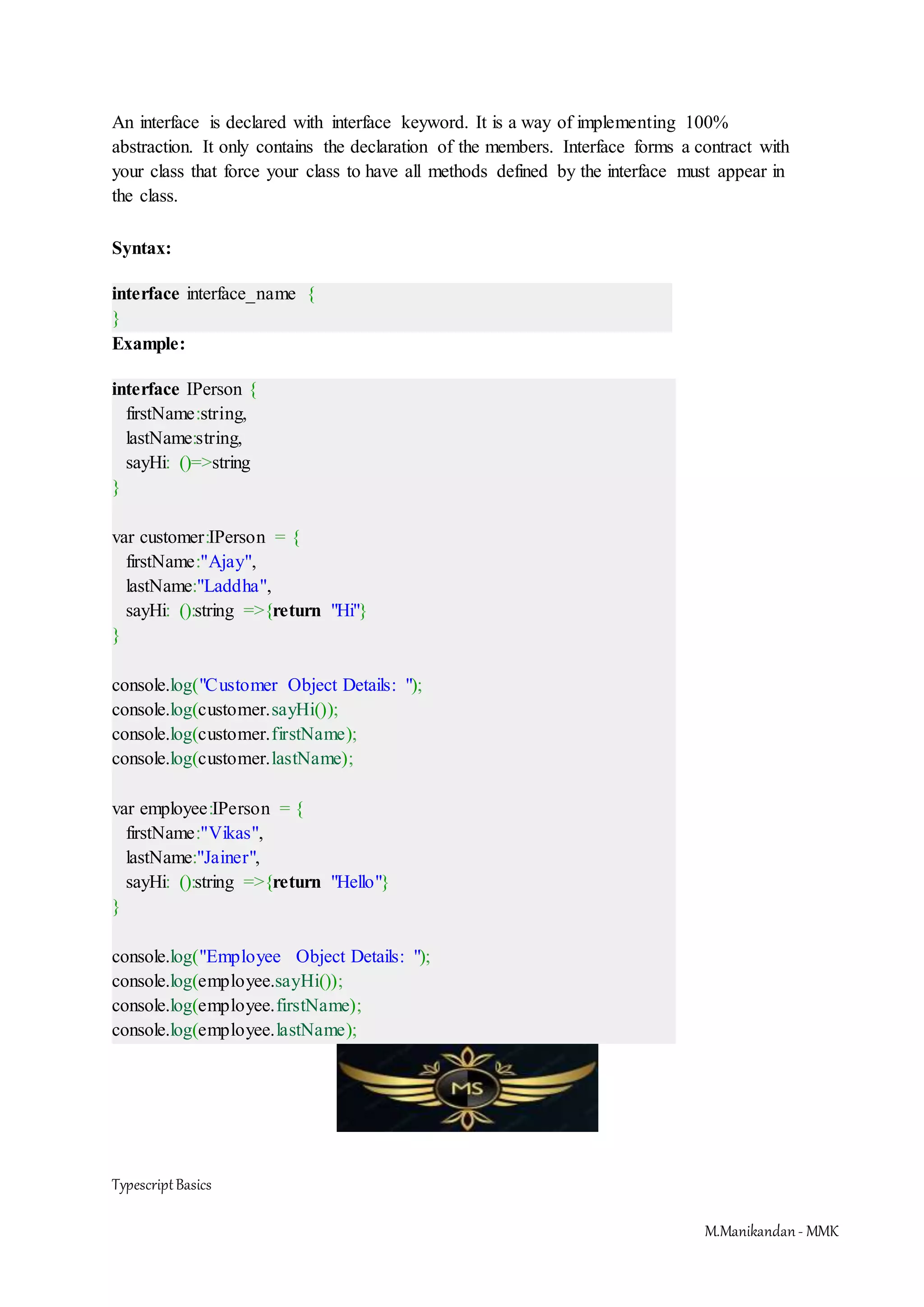
![TypescriptBasics M.Manikandan- MMK Typescript Class TypeScript Class: As we discussed in earlier tutorials that TypeScript supports object-oriented programming concepts like classes, interfaces, etc. Class acts as a blue print or template for creating objects. It provides state and behaviour for its objects. A class is used to encapsulate the data for the object. Syntax: class class_name { //field //constructor //function } Typescript creating objects: The new keyword followed by the class name is used to create an instance of the class. var objectName = new className([ arguments ]) Example: class Employee { //field name:string; //constructor constructor(name:string) { this.name = name; } //function display():void { console.log("Employee Name: "+this.name); } } //create an object](https://image.slidesharecdn.com/typescripttutorial-211219084103/75/Typescript-Basics-35-2048.jpg)
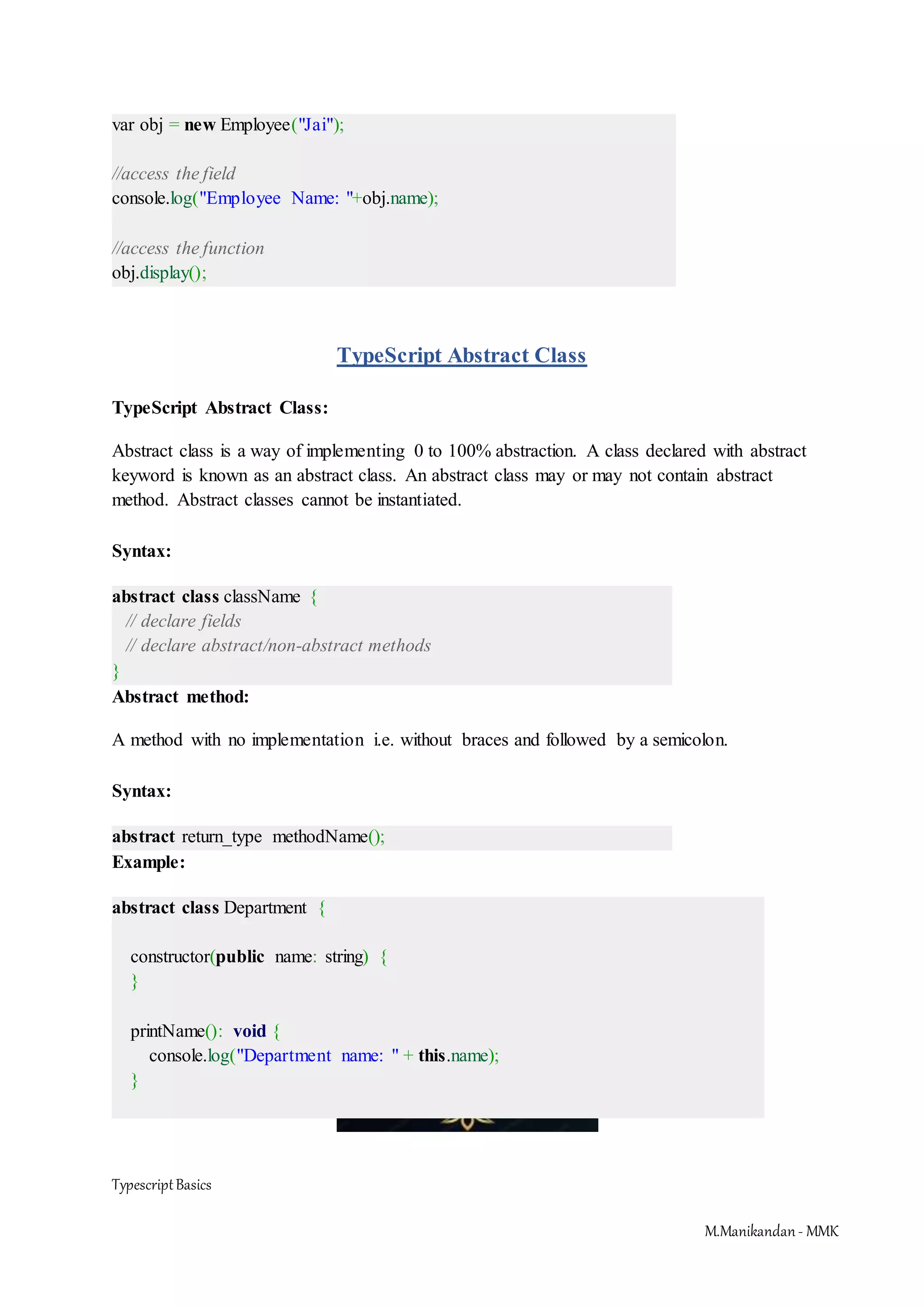
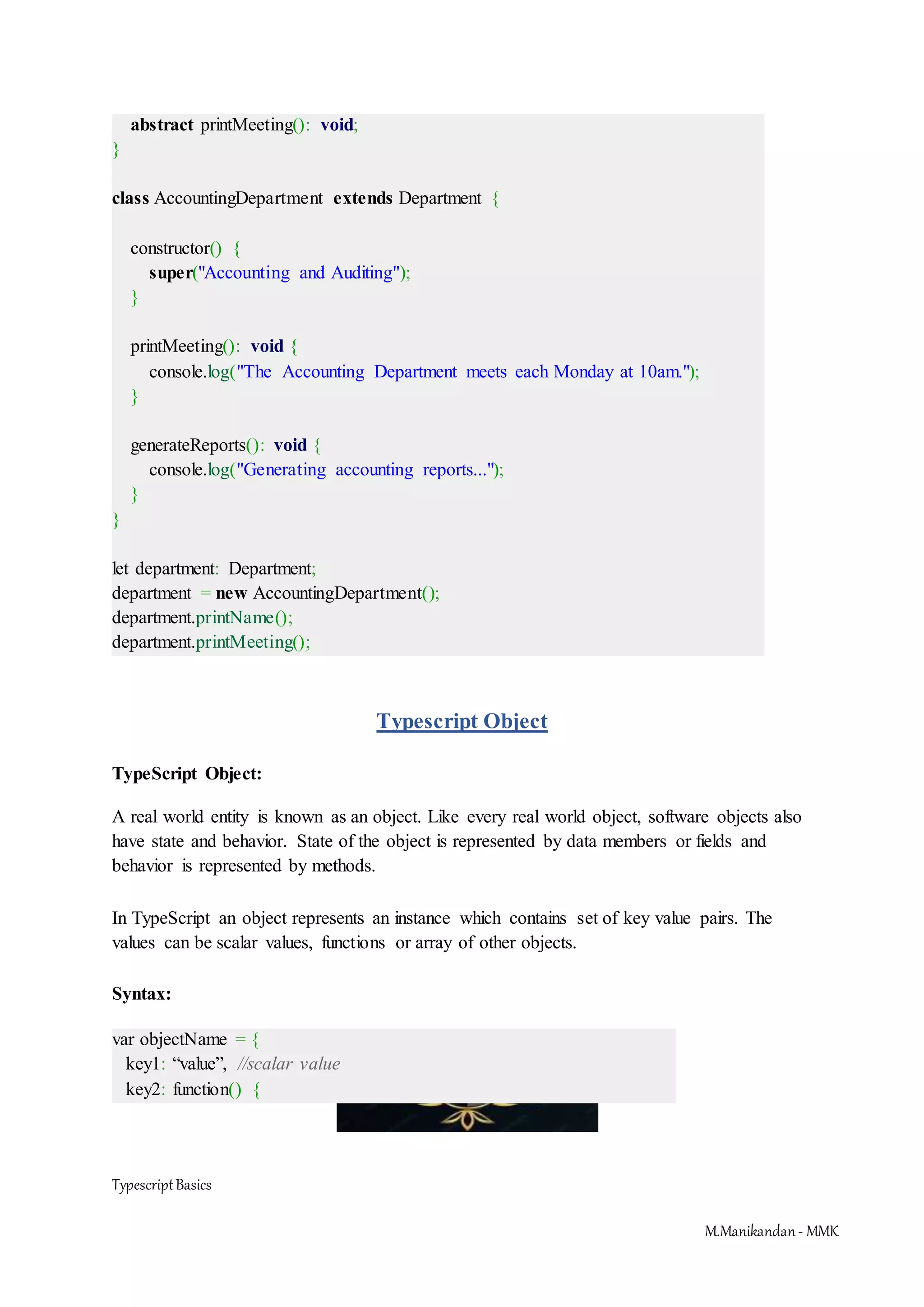
![TypescriptBasics M.Manikandan- MMK //functions }, Key3:[“content1”, “content2”] //collection }; Example: class Employee { //field name:string; empId:string; } //function var display = function(obj: {name:string, empId:string}) { console.log("Employee Name: "+obj.name); console.log("Employee EmpId: "+obj.empId); } //create an object var obj:Employee = {name:"Jai", empId:"EMP024"}; //access the function display(obj); Typescript Duck Typing TypeScript duck typing: Duck-typing is a powerful feature which brings strong typing concepts in TypeScript code. TypeScript provides the duck typing type-checking which focus on the shape that values have. It checks for the presence of certain properties in the objects instead of the actual object type. The following example does not allow substitution of a Parrot for a Duck, because the Duck class has an additional method (so Parrot fails duck typing). Sparrows and Parrots are apparently substitutable in duck typing because there’s nothing a](https://image.slidesharecdn.com/typescripttutorial-211219084103/75/Typescript-Basics-38-2048.jpg)
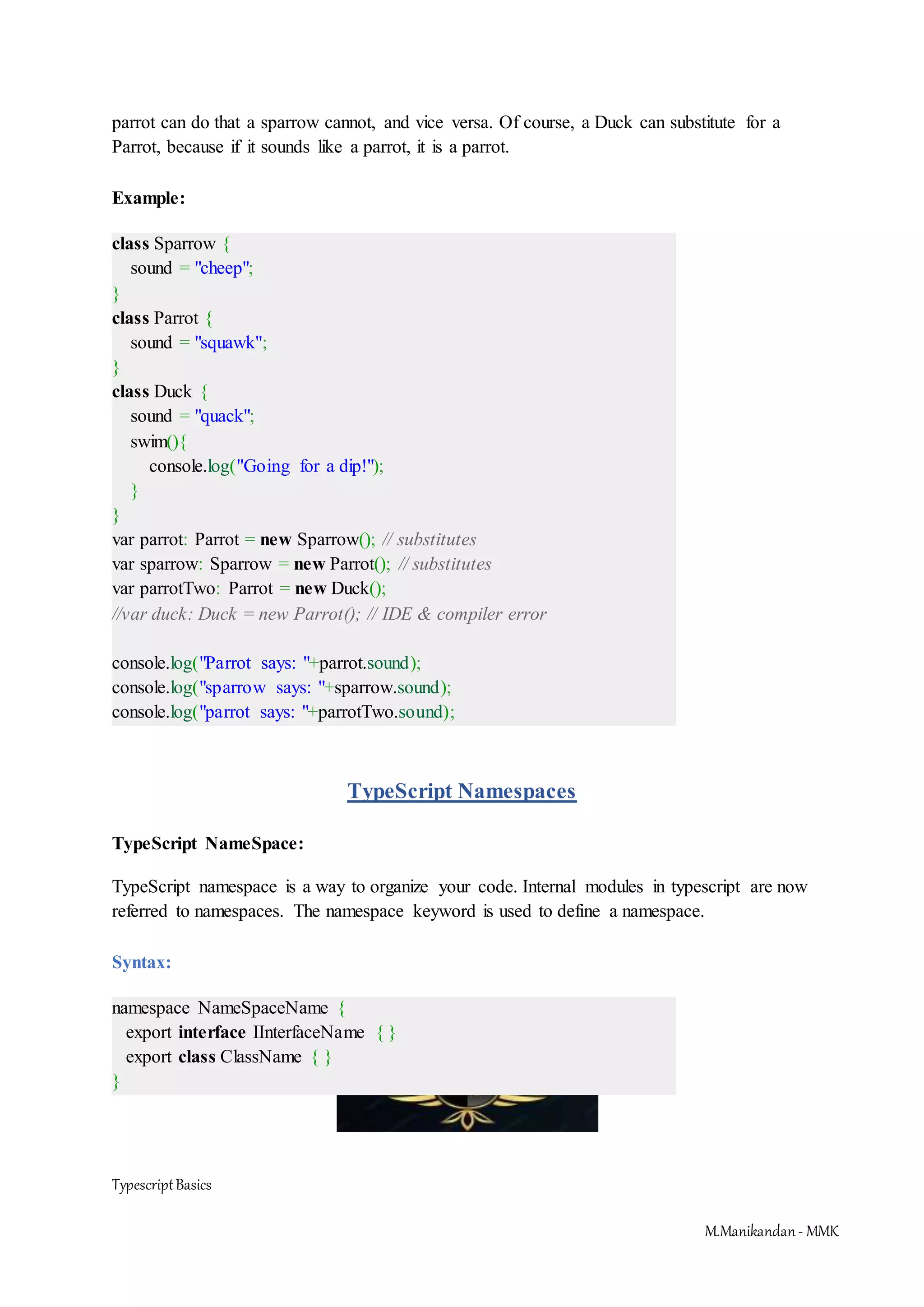
![TypescriptBasics M.Manikandan- MMK Access the class or interface in another namespace: NameSpaceName.ClassName; Example: namespace Validation { export interface StringValidator { isValid(s: string): boolean; } const lettersRegexp = /^[A-Za-z]+$/; const numberRegexp = /^[0-9]+$/; export class LettersOnlyValidator implements StringValidator { isValid(s: string) { return lettersRegexp.test(s); } } export class ZipCodeValidator implements StringValidator { isValid(s: string) { return s.length === 5 && numberRegexp.test(s); } } } //Some samples to try let strings = ["You", "53454", "Hello"]; // Validators to use let validators: { [s: string]: Validation.StringValidator; } = {}; validators["ZIP code"] = new Validation.ZipCodeValidator(); validators["Letters only"] = new Validation.LettersOnlyValidator(); //Show whether each string passed each validator for (let s of strings) { for (let name in validators) { console.log(`"${ s }" - ${ validators[name].isValid(s) ? "Valid" : "Invalid" } ${ name }`); } }](https://image.slidesharecdn.com/typescripttutorial-211219084103/75/Typescript-Basics-40-2048.jpg)
![TypescriptBasics M.Manikandan- MMK TypeScript Multi-file namespaces: We can split the namespace into multiple files. As these multiple files will have dependencies we have to add reference tag to tell the compiler about the relationships between the files. /// <reference path = "FileName.ts" /> Example: Validation.ts namespace Validation { export interface StringValidator { isValid (s: string): boolean; } } LettersValidator.ts /// <reference path="Validation.ts" /> namespace Validation { const lettersRegexp = /^[A-Za-z]+$/; export class LettersOnlyValidator implements StringValidator { isValid (s: string) { return lettersRegexp.test(s); } } } ZipCodeValidator.ts /// <reference path="Validation.ts" /> namespace Validation { const numberRegexp = /^[0-9]+$/; export class ZipCodeValidator implements StringValidator { isValid (s: string) { return s.length === 5 && numberRegexp.test(s); } } } Test.ts](https://image.slidesharecdn.com/typescripttutorial-211219084103/75/Typescript-Basics-41-2048.jpg)
![TypescriptBasics M.Manikandan- MMK /// <reference path="Validation.ts" /> /// <reference path="LettersValidator.ts" /> /// <reference path="ZipCodeValidator.ts" /> //Some samples to try let strings = ["You", "53454", "Hello"]; // Validators to use let validators: { [s: string]: Validation.StringValidator; } = {}; validators["ZIP code"] = new Validation.ZipCodeValidator(); validators["Letters only"] = new Validation.LettersOnlyValidator(); //Show whether each string passed each validator for (let s of strings) { for (let name in validators) { console.log(`"${ s }" - ${ validators[name].isValid(s) ? "Valid" : "Invalid" } ${ name }`); } } TypeScript Module TypeScript module: A module refers to a set of standardized parts or independent units that can be used to construct a more complex structure. TypeScript modules provides a way to organize the code for better reuse. Syntax: export interface InterfaceName { //Block of statements } The import keyword is used to use the declared module in another file. import testInterfaceRef = require(“./InterfaceName”); Example: IShowDetails.ts](https://image.slidesharecdn.com/typescripttutorial-211219084103/75/Typescript-Basics-42-2048.jpg)
